1010 Analytical data interpretation and treatment 分析数据解释及处理
USP39 General chapters 目录(优选.)

最新文件---------------- 仅供参考--------------------已改成-----------word文本 --------------------- 方便更改赠人玫瑰,手留余香。
General chapters备注:蓝色字体章节为新增内容,红色字体章节为在USP38基本上修改内容。
〈1〉Injections, 53〈2〉Oral drug products—product quality tests, 66〈3〉Topical and transdermal drug products—product quality tests, 71〈5〉Inhalation and nasal drug products general information and product quality tests, 80〈11〉USP reference standards, 93〈17〉Prescription container labeling, 96〈21〉Thermometers, 98〈31〉V olumetric apparatus, 99〈41〉Weights and balances, 99〈51〉Antimicrobial effectiveness testing,100〈55〉 Biological indicators—resistance performance tests, 103〈61〉Microbiological examination of nonsterile products: microbial enumeration tests, 106〈62〉Microbiological examination of nonsterile products: tests for specified organisms, 112〈63〉Mycoplasma tests, 120〈71〉Sterility tests, 125〈81〉Antibiotics—microbial assays, 133〈85〉Bacterial endotoxins test, 151〈87〉Biological reactivity tests, in vitro, 156〈88〉Biological reactivity tests, in vivo, 158〈90〉Fetal bovine serum quality attributes and functionality tests, 167〈91〉Calcium pantothenate assay, 171〈92〉Growth factors and cytokines used in cell therapy manufacturing, 172〈111〉 Design and analysis of biological assays, 176〈115〉 Dexpanthenol assay, 191〈121〉 Insulin assays, 193〈121.1〉 Physicochemical analytical procedures for insulins, 195〈123〉 Glucagon bioidentity tests, 198〈124〉 Erythropoietin bioassays, 200〈126〉 Somatropin bioidentity tests, 202<129> Analytical Procedures for Recombinant Therapeutic Monoclonal Antibodies〈130〉 Protein A quality attributes, 204〈151〉 Pyrogen test, 211〈161〉 Transfusion and infusion assemblies and similar medical devices, 212<162> Diphtheria Antitoxin Potency Testing for Human Immune Globulins〈171〉V itamin B12activity assay, 213〈181〉 Identification—organic nitrogenous bases, 216〈191〉 Identification tests—general, 216〈193〉 Identification—tetracyclines, 219〈197〉 Spectrophotometric identification tests, 220〈201〉 Thin-layer chromatographic identification test, 221〈206〉 Aluminum, 222〈207〉 Test for 1,6-anhydro derivative for enoxaparin sodium, 223〈208〉 Anti-factor Xa and anti-factor IIa assays for unfractionated and low molecular weight heparins, 228〈211〉 Arsenic, 233〈221〉 Chloride and sulfate, 235〈223〉 Dimethylaniline, 236〈226〉 4-Epianhydrotetracycline, 236〈227〉 4-Aminophenol in acetaminophen-containing drug products, 237〈228〉 Ethylene oxide and dioxane, 238〈231〉 Heavy metals, 241〈232〉 Elemental impurities—limits, 243〈233〉 Elemental impurities—procedures,245〈241〉 Iron, 249〈251〉 Lead, 250〈261〉 Mercury, 251〈267〉 Porosimetry by mercury intrusion,253〈268〉 Porosity by nitrogen adsorption–desorption, 256〈271〉 Readily carbonizable substances test,260〈281〉 Residue on ignition, 260〈291〉 Selenium, 261〈301〉 Acid-neutralizing capacity, 261〈311〉 Alginates assay, 262〈341〉 Antimicrobial agents—content, 264〈345〉 Assay for citric acid/citrate and phosphate, 267〈351〉 Assay for steroids, 268〈361〉 Barbiturate assay, 268〈371〉 Cobalamin radiotracer assay, 268〈381〉 Elastomeric closures for injections,270〈391〉 Epinephrine assay, 275〈401〉 Fats and fixed oils, 276〈411〉 Folic acid assay, 290〈413〉 Impurities testing in medical gases,290〈415〉 Medical gases assay, 291〈425〉 Iodometric assay—antibiotics, 293〈429〉 Light diffraction measurement of particle size, 294 〈431〉 Methoxy determination, 299〈441〉 Niacin or niacinamide assay, 301〈451〉 Nitrite titration, 306〈461〉 Nitrogen determination, 306〈466〉 Ordinary impurities, 307〈467〉 Residual solvents, 309〈469〉 Ethylene glycol, diethylene glycol,and triethylene glycol in ethoxylated substances, 324〈471〉 Oxygen flask combustion, 325〈481〉 Riboflavin assay, 326〈501〉 Salts of organic nitrogenous bases,327〈503〉 Acetic acid in peptides, 327<503.1> Trifluoroacetic Acid (TFA) in Peptides〈511〉 Single-steroid assay, 328〈525〉 Sulfur dioxide, 329〈531〉 Thiamine assay, 334〈541〉 Titrimetry, 335〈551〉V itamin E assay, 338〈561〉 Articles of botanical origin, 345〈563〉 Identification of articles of botanical origin, 358〈565〉 Botanical extracts, 370〈571〉V itamin A assay, 373<580> Vitamin C Assay〈581〉V itamin D assay, 378〈591〉 Zinc determination, 387〈601〉 Inhalation and nasal drug products:aerosols, sprays, andpowders–performance quality tests, 388〈602〉 Propellants, 414〈603〉 Topical aerosols, 415〈604〉 Leak rate, 416〈610〉 Inhalation and nasal drug products:aerosols, sprays, and powders–performance quality tests, 416〈611〉 Alcohol determination, 418〈616〉 Bulk density and tapped density, 420〈621〉 Chromatography, 424〈631〉 Color and achromicity, 434〈641〉 Completeness of solution, 436〈643〉 Total organic carbon, 436〈645〉 Water conductivity, 438〈651〉 Congealing temperature, 441〈659〉 Packaging and storage requirements,443〈660〉 Containers—glass, 450〈661〉 Containers—plastics, 457<661.1> Plastic Materials of Construction<661.2> Plastic Packaging Systems for Pharmaceutical Use〈670〉 Containers—Auxiliary Components〈671〉 Containers—performance testing,465〈691〉 Cotton, 472〈695〉 Crystallinity, 474〈696〉 Crystallinity determination by solution calorimetry, 474〈698〉 Deliverable volume, 478〈699〉 Density of solids, 481〈701〉 Disintegration, 483〈705〉 Quality attributes of tablets labeled as having a functional score, 485〈711〉 Dissolution, 486〈721〉 Distilling range, 496〈724〉 Drug release, 497〈729〉 Globule size distribution in lipid injectable emulsions, 504〈730〉 Plasma spectrochemistry, 506〈731〉 Loss on drying, 513〈733〉 Loss on ignition, 514〈735〉 X-ray fluorescence spectrometry, 514〈736〉 Mass spectrometry, 519〈741〉 Melting range or temperature, 525〈751〉 Metal particles in ophthalmic ointments, 527〈755〉 Minimum fill, 527〈761〉 Nuclear magnetic resonance, 528〈771〉 Ophthalmic Products—Quality Tests〈776〉 Optical microscopy, 537〈781〉 Optical rotation, 540〈785〉 Osmolality and osmolarity, 541〈786〉 Particle size distribution estimation by analytical sieving, 543〈787〉 Subvisible particulate matter in therapeutic protein injections, 547〈788〉 Particulate matter in injections, 550〈789〉 Particulate matter in ophthalmic solutions, 553〈790〉Visible Particulates in Injections〈791〉 pH, 556〈795〉 Pharmaceutical compounding—nonsterile preparations, 559〈797〉 Pharmaceutical compounding—sterile preparations, 567〈801〉 Polarography, 611〈811〉 Powder fineness, 616〈821〉 Radioactivity, 616〈823〉 Positron emission tomography drugs for compounding, investigational, andresearch uses, 627〈831〉 Refractive index, 636〈841〉 Specific gravity, 636〈846〉 Specific surface area, 638〈851〉 Spectrophotometry and light-scattering, 641<855> Nephelometry, Turbidimetry, and Visual Comparison〈861〉 Sutures—diameter, 669〈871〉 Sutures—needle attachment, 670〈881〉 Tensile strength, 671〈891〉 Thermal analysis, 672〈905〉 Uniformity of dosage units, 675〈911〉V iscosity—capillar y viscometer methods, 679〈912〉 Rotational rheometer methods, 681〈913〉 Rolling ball viscometer method, 686<914> Viscosity-Pressure Driven Methods〈921〉 Water determination, 688〈941〉 Characterization of crystalline and partially crystalline solids by X-ray powder diffraction (XRPD), 692〈1005〉 Acoustic emission, 699〈1010〉 Analytical data—interpretation and treatment, 703〈1015〉 Automated radiochemical synthesis apparatus, 717〈1024〉 Bovine serum, 719〈1027〉 Flow cytometry, 732〈1030〉 Biological assay chapters—overview and glossary, 748〈1031〉 The biocompatibility of materials used in drug containers, medical devices, and implants, 759〈1032〉 Design and development of biological assays, 769〈1033〉 Biological assay validation, 787〈1034〉 Analysis of biological assays, 801〈1035〉 Biological indicators for sterilization,814〈1041〉 Biologics, 818〈1043〉 Ancillary materials for cell, gene,and tissue-engineered products, 819〈1044〉 Cryopreservation of cells, 827〈1045〉 Biotechnology-derived articles, 840〈1046〉 Cellular and tissue-based products,854〈1047〉 Gene therapy products, 883〈1048〉 Quality of biotechnological products: analysis of the expressionconstruct in cells used for production of r-DNA derived protein roducts, 911〈1049〉 Quality of biotechnological products: stability testing of biotechnological/biological products,913〈1050〉Viral safety evaluation of biotechnology products derived from cell lines of human or animal origin, 918〈1051〉 Cleaning glass apparatus, 931〈1052〉 Biotechnology-derived articles—amino acid analysis, 931〈1053〉 Biotechnology-derived articles—capillary electrophoresis, 944〈1054〉 Biotechnology-derived articles—isoelectric focusing, 951〈1055〉 Biotechnology-derived articles—peptide mapping, 954〈1056〉 Biotechnology-derived articles—polyacrylamide gel electrophoresis, 960〈1057〉 Biotechnology-derived articles—total protein assay, 967〈1058〉 Analytical instrument qualification,971〈1059〉 Excipient performance, 977〈1061〉 Color—instrumental measurement,997〈1065〉 Ion chromatography, 1000〈1066〉 Physical environments that promote safe medication use, 1003〈1072〉 Disinfectants and antiseptics, 1010〈1074〉 Excipient biological safety evaluation guidelines, 1015〈1078〉 Good manufacturing practices for bulk pharmaceutical excipients, 1019〈1079〉 Good storage and shipping practices, 1035〈1080〉 Bulk pharmaceutical excipients—certificate of analysis, 1044〈1084〉 Glycoprotein and glycan analysis—general considerations, 1052〈1086〉 Impurities in official articles, 1063〈1087〉 Apparent intrinsic dissolution—dissolution testing procedures for rotating disk and stationary disk, 1066〈1088〉 In vitro and in vivo evaluation of dosage forms, 1070〈1090〉 Assessment of drug product performance—bioavailability, bioequivalence, and dissolution, 1081〈1091〉 Labeling of inactive ingredients,1089〈1092〉 The dissolution procedure:development and validation, 1090〈1094〉 Capsules—dissolution testing and related quality attributes, 1097〈1097〉 Bulk powder sampling procedures,1105〈1102〉 Immunological test methods—general considerations, 1118〈1103〉 Immunological test methods— enzyme-linked immunosorbent assay (ELISA), 1125〈1104〉 Immunological test methods—immunoblot analysis, 1135〈1105〉 Immunological test methods—surface plasmon resonance, 1146〈1106〉 Immunogenicity assays—design and validation of immunoassays to detect anti-drug antibodies, 1161〈1111〉 Microbiological examination of nonsterile products: acceptance criteria for pharmaceutical preparations and substances forpharmaceutical use, 1176〈1112〉 Application of water activity determination to nonsterile pharmaceutical products, 1178〈1113〉 Microbial characterization, identification, and strain typing, 1180〈1115〉 Bioburden control of nonsterile drug substances and products, 1185〈1116〉Microbiological control and monitoring of aseptic processing environments, 1191〈1117〉 Microbiological best laboratory practices, 1204〈1118〉 Monitoring devices—time, temperature, and humidity, 1210〈1119〉 Near-infrared spectrophotometry,1215〈1120〉 Raman spectroscopy, 1222〈1121〉 Nomenclature, 1230〈1125〉 Nucleic acid-based techniques—general, 1232〈1126〉 Nucleic acid-based techniques—extraction, detection, and sequencing,1237〈1127〉 Nucleic acid-based techniques—amplification, 1247〈1128〉 Nucleic acid-based techniques—microarray, 1256〈1129〉 Nucleic acid-based techniques—genotyping, 1262〈1130〉 Nucleic acid-based techniques— approaches for detecting trace nucleic acids (residual DNA testing), 1267〈1136〉 Packaging—unit-of-use, 1269〈1151〉 Pharmaceutical dosage forms, 1278〈1160〉 Pharmaceutical calculations in prescription compounding, 1303〈1163〉 Quality assurance in pharmaceutical compounding, 1317〈1171〉 Phase-solubility analysis, 1324〈1174〉 Powder flow, 1326〈1176〉 Prescription balances and volumetric apparatus, 1331〈1177〉 Good packaging practices, 1332〈1178〉 Good repackaging practices, 1335〈1180〉 Human plasma, 1337〈1181〉 Scanning electron microscopy,1360〈1184〉 Sensitization testing, 1370〈1191〉 Stability considerations in dispensing practice, 1381〈1195〉 Significant change guide for bulk pharmaceutical excipients, 1385〈1197〉 Good distribution practices for bulk pharmaceutical excipients, 1396〈1207〉 Sterile product packaging—integrity evaluation, 1418〈1208〉 Sterility testing—validation of isolator systems, 1420〈1209〉 Sterilization—chemical and physicochemical indicators and integrators, 1424〈1211〉 Sterilization and sterility assurance of compendial articles, 1427〈1216〉 Tablet friability, 1432〈1217〉 Tablet breaking, 1433〈1222〉 Terminally sterilized pharmaceutical products—parametric release, 1436〈1223〉 Validation of alternative microbiological methods, 1439〈1224〉 Transfer of analytical procedures,1443〈1225〉 Validation of compendial procedures, 1445〈1226〉 Verification of compendial procedures, 1451〈1227〉 Validation of microbial recovery from pharmacopeial articles, 1452〈1229〉 Sterilization of compendial articles,1456〈1229.1〉 Steam sterilization by direct contact, 1461〈1229.2〉 Moist heat sterilization of aqueous liquids, 1464〈1229.3〉 Monitoring of bioburden, 1468〈1229.4〉 Sterilizing filtration of liquids,1472〈1229.6〉 Liquid-phase sterilization, 1479〈1229.7〉 Gaseous sterilization, 1482〈1229.8〉 Dry heat sterilization, 1485〈1229.10〉 Radiation sterilization, 1487〈1230〉 Water for hemodialysis applications,1491〈1231〉 Water for pharmaceutical purposes,1492〈1234〉 Vaccines for human use— polysaccharide and glycoconjugate vaccines, 1518〈1235〉 Vaccines for human use—general considerations, 1534〈1237〉 Virology test methods, 1550〈1238〉 Vaccines for human use—bacterial vaccines, 1570〈1240〉 Virus testing of human plasma for further manufacture, 1582〈1241〉 Water–solid interactions in pharmaceutical systems, 1592〈1251〉 Weighing on an analytical balance,1597〈1265〉 Written prescription drug information—guidelines, 1602〈1285〉 Preparation of biological specimens for histologic and immunohistochemical analysis, 1603〈1285.1〉 Hematoxylin and eosin staining of sectioned tissue for microscopic examination, 1607〈1601〉 Products for nebulization—characterization tests, 1610〈1644〉 Theory and practice of electrical conductivity measurements of solutions,1613〈1660〉 Evaluation of the inner surface durability of glass containers, 1620<1661> Evaluation of Plastic Packaging Systems and Their Materials of Construction with Respect to Their User Safety Impact〈1724〉 Semi-solid drug products—performance tests, 1625<1730> Plasma Spectrochemistry—Theory and Practice<1735> X-Ray Fluorescence Spectrometry —Theory and Practice〈1736〉 Applications of mass spectrometry,1637〈1761〉 Applications of nuclear magnetic resonance spectroscopy, 1659<1771> Ophthalmic Products—Performance Tests〈1788〉 Methods for the determination of particulate matter in injections and ophthalmic solutions, 1693〈1911〉 Rheometry, 1742〈2021〉 Microbial enumeration tests—nutritional and dietary supplements,1751〈2022〉 Microbiological procedures for absence of specified microorganisms— nutritional and dietary supplements,1756〈2023〉 Microbiological attributes of nonsterile nutritional and dietary supplements, 1762〈2030〉 Supplemental information for articles of botanical origin, 1765<2040> Disintegration and Dissolution of Dietary Supplements〈2091〉 Weight variation of dietary supplements, 1782〈2232〉 Elemental contaminants in dietary supplements, 1783〈2250〉 Detection of irradiated dietary supplements, 1786〈2750〉 Manufacturing practices for dietary supplements, 1789最新文件---------------- 仅供参考--------------------已改成-----------word文本 --------------------- 方便更改赠人玫瑰,手留余香。
1010_Analytical_data_interpretation_and_treatment_分析数据解释及处理
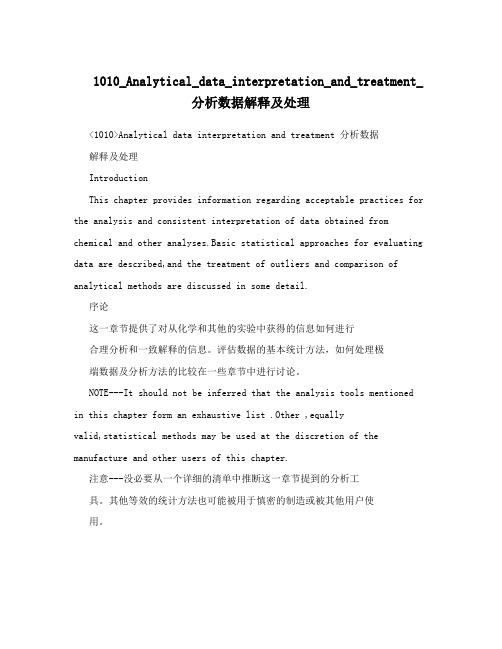
1010_Analytical_data_interpretation_and_treatment_分析数据解释及处理<1010>Analytical data interpretation and treatment 分析数据解释及处理IntroductionThis chapter provides information regarding acceptable practices for the analysis and consistent interpretation of data obtained from chemical and other analyses.Basic statistical approaches for evaluating data are described,and the treatment of outliers and comparison of analytical methods are discussed in some detail.序论这一章节提供了对从化学和其他的实验中获得的信息如何进行合理分析和一致解释的信息。
评估数据的基本统计方法,如何处理极端数据及分析方法的比较在一些章节中进行讨论。
NOTE---It should not be inferred that the analysis tools mentioned in this chapter form an exhaustive list .Other ,equallyvalid,statistical methods may be used at the discretion of the manufacture and other users of this chapter.注意---没必要从一个详细的清单中推断这一章节提到的分析工具。
其他等效的统计方法也可能被用于慎密的制造或被其他用户使用。
英语毕业综合实践任务书(2篇)

第1篇Task Title: Exploration and Analysis of the Impact of Social Media on Youth DevelopmentStudent Name: [Your Name]Student ID: [Your Student ID]Department: [Your Department]Major: [Your Major]Supervisor: [Supervisor’s Name]Date of Issue: [Date]Introduction:This comprehensive practice task aims to explore and analyze the impact of social media on the development of young people in today’s digital age. As the world becomes increasingly interconnected through digital platforms, it is crucial to understand the effects of social media on various aspects of youth development, including psychological, social, and academic domains. The task will involve both theoretical research and practical application, enabling students to synthesize knowledge from different disciplines and develop critical thinking skills.Task Objectives:1. To understand the historical and contemporary context of social media development.2. To analyze the psychological, social, and academic impacts of social media on youth.3. To evaluate the potential benefits and drawbacks of social media in the lives of young people.4. To develop practical strategies for promoting positive social media usage among youth.5. To enhance research, analytical, and communication skills through the completion of this task.Task Duration:The comprehensive practice task is expected to be completed within [X] weeks, starting from [Start Date] to [End Date].Task Structure:1. Literature Review (Weeks 1-2):- Conduct a thorough review of existing literature on social media and youth development.- Identify key theories, research findings, and debates in the field.- Synthesize the findings from various academic disciplines, such as psychology, sociology, and communication studies.2. Research Design (Weeks 3-4):- Define the research objectives and hypotheses.- Select appropriate research methods (e.g., surveys, interviews, case studies).- Develop a research instrument or protocol.- Seek approval from the relevant ethics committee if necessary.3. Data Collection (Weeks 5-6):- Implement the research design to collect data from a sample of young people.- Analyze the collected data using appropriate statistical or qualitative analysis techniques.- Ensure the confidentiality and ethical treatment of participants.4. Data Analysis and Interpretation (Weeks 7-8):- Analyze the data to identify patterns, trends, and relationships.- Interpret the findings in the context of existing literature and theories.- Discuss the implications of the findings for social media policy and practice.5. Report Writing (Weeks 9-10):- Write a comprehensive report summarizing the research process, findings, and conclusions.- Include an introduction, literature review, methodology, results, discussion, and conclusion sections.- Follow the formatting and citation guidelines provided by the department.6. Presentation and Defense (Weeks 11-12):- Prepare a presentation summarizing the research findings and their implications.- Present the findings to the supervisor and other relevant faculty members.- Defend the research findings and answer questions from the audience.Task Requirements:1. Literature Review:- A comprehensive literature review of at least 20 academic articles or books.- A clear and concise summary of the key findings and debates in the field.2. Research Design:- A detailed research proposal including objectives, hypotheses, methods, and ethical considerations.- Approval from the relevant ethics committee (if applicable).3. Data Collection:- A research instrument or protocol that is clear, unbiased, and appropriate for the research objectives.- A minimum of 50 completed research instruments or interviews.4. Data Analysis:- A clear and systematic analysis of the collected data.- Use of appropriate statistical or qualitative analysis techniques.- A detailed discussion of the findings.5. Report Writing:- A well-structured, comprehensive report following the department’s formatting and citation guidelines.- A clear, concise, and logical presentation of the research process, findings, and conclusions.6. Presentation and Defense:- A well-prepared presentation that effectively communicates the research findings.- A strong defense of the research findings and conclusions.Evaluation Criteria:1. The quality and depth of the literature review.2. The clarity and appropriateness of the research design.3. The thoroughness and accuracy of the data collection and analysis.4. The clarity, coherence, and organization of the report.5. The effectiveness of the presentation and defense.Submission Dates:1. Literature Review: [Submission Date]2. Research Proposal: [Submission Date]3. Data Collection Instrument/Protocol: [Submission Date]4. Data Analysis and Interpretation: [Submission Date]5. Final Report: [Submission Date]6. Presentation and Defense: [Presentation Date]Supervisor’s Responsibiliti es:- Provide guidance and support throughout the research process.- Review and provide feedback on the literature review, research proposal, data collection instrument/protocol, data analysis, and final report.- Attend the presentation and defense to ev aluate the student’s performance.Student’s Responsibilities:- Complete the comprehensive practice task within the specified time frame.- Communicate regularly with the supervisor regarding progress and any issues encountered.- Ensure the confidentiality and ethical treatment of participants.- Follow the department’s formatting and citation guidelines.Conclusion:This graduation comprehensive practice task will provide an excellent opportunity for students to delve into the complex relationship between social media and youth development. By completing this task, students will not only enhance their research and analytical skills but also contribute to the understanding of this critical issue in today’s society.第2篇Title: Exploring the Impact of Technological Advancements on Education: A Case Study of Smart Classroom ImplementationObjective:The primary objective of this comprehensive practice task is to enable students to apply their theoretical knowledge and skills in a practical setting. Through this project, students will gain hands-on experience in analyzing the impact of technological advancements, particularly smart classroom implementation, on the educational sector. This task aims to enhance critical thinking, problem-solving, and research skills while fostering a deeper understanding of the subject matter.Duration:The comprehensive practice task will be carried out over a period of 12 weeks, starting from [Insert Start Date] to [Insert End Date].Participants:This task is designed for [Insert Number] students of [Insert Department/Program Name], [Insert University Name].Task Overview:The comprehensive practice task will be divided into several phases, each focusing on different aspects of the project. The following is a detailed outline of the task:Phase 1: Literature Review (Weeks 1-2)- Students will conduct a thorough literature review on the impact of technological advancements on education, with a specific focus on smart classroom implementation.- Students will identify key theories, research findings, and debates related to the topic.- Students will develop a research question that will guide their project.Phase 2: Case Study Selection (Weeks 3-4)- Students will select a case study of a school or educationalinstitution that has implemented smart classrooms.- Students will analyze the selection criteria for their case study, ensuring it is relevant, accessible, and representative of the broader educational context.Phase 3: Data Collection (Weeks 5-7)- Students will collect data from the selected case study throughvarious methods, such as interviews, surveys, observations, and document analysis.- Students will ensure that their data collection methods are ethical, reliable, and valid.Phase 4: Data Analysis (Weeks 8-9)- Students will analyze the collected data, identifying patterns, trends, and relationships between technological advancements and educational outcomes.- Students will use appropriate statistical and qualitative analysis techniques to interpret their findings.Phase 5: Report Writing (Weeks 10-11)- Students will write a comprehensive report that includes an introduction, literature review, methodology, results, discussion, and conclusion.- The report should provide a clear and concise overview of the project, highlighting key findings and their implications for the educational sector.Phase 6: Presentation and Defense (Weeks 12)- Students will present their findings to a panel of faculty members and peers.- Students will be prepared to answer questions and defend theirresearch methodology and conclusions.Task Requirements:1. Literature Review:- A comprehensive literature review of at least 15 academic sources, including peer-reviewed articles, books, and conference papers.- A research question that clearly outlines the scope and objectives of the project.2. Case Study:- A detailed case study report that includes an introduction, methodology, results, discussion, and conclusion.- A minimum of 10 interviews with stakeholders (teachers, students, administrators) involved in the smart classroom implementation.3. Data Analysis:- A detailed analysis of the collected data, including statistical and qualitative findings.- A discussion of the implications of the findings for the educational sector.4. Report:- A well-structured, 20-page report that adheres to academic writing standards.- Proper citation of all sources used in the project.5. Presentation:- A PowerPoint presentation that effectively communicates theproject's objectives, methodology, results, and conclusions.- A clear and concise oral defense of the project's findings and methodology.Evaluation Criteria:1. Literature Review (20%): The quality and depth of the literature review, research question clarity, and relevance to the case study.2. Case Study (30%): The thoroughness of the case study, the quality of data collection and analysis, and the relevance of findings to the research question.3. Data Analysis (20%): The appropriateness of the analysis techniques, the accuracy of the findings, and the discussion of their implications.4. Report (20%): The overall quality of the report, including structure, clarity, and adherence to academic writing standards.5. Presentation and Defense (10%): The effectiveness of the presentation, the clarity of communication, and the ability to answer questions and defend the project.Submission and Deadlines:All tasks must be submitted to the designated dropbox or folder by the respective deadlines:- Literature Review and Research Question (Week 2):- Case Study Report (Week 11):- Data Analysis and Report (Week 11):- Presentation and Defense (Week 12):Additional Information:- Students are encouraged to seek guidance from their faculty advisor throughout the project.- Regular progress reports should be submitted to the faculty advisor at the end of each phase.- Any ethical concerns or issues should be addressed immediately withthe faculty advisor or the university's ethics committee.By completing this comprehensive practice task, students will not only enhance their academic and professional skills but also contribute valuable insights to the ongoing discussion on the role of technology in education.。
USP1010_分析数据解析与处理_CN
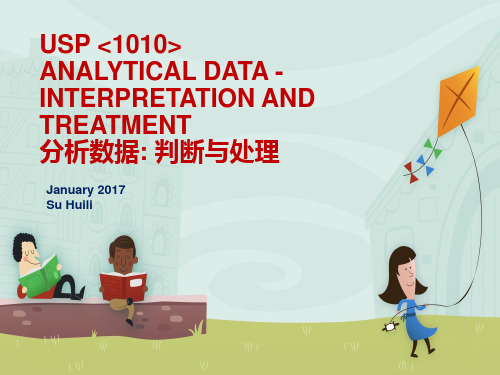
检测原则与变异
如: 变量呈正态分布, 但右边拖尾更长. 此类分布 通常可以进行对数转换, 使之更呈正态. 另一个方法就是使用”分布不拘”或”非参数”统 计法, 这些方法不需要集合形状为正态分布. 若需要建立平均值或平均值差异的置信区间, 根 据中心极限定理central limit theorem, 正态假 设就显得不重要了
• 有效的取样是评估总体质量特性的重要步骤; 取 样目的是提供代表性数据(样品数据),以评估总体 特性. • 如何取样与样品数据有关 • 随机取样是合适的取样方法. 必须随机, 独立取 样, 确保生成的数据能够有效评估总体特性. • 非随机或”方便”的样本存在偏见性评估可能性 的风险
实验室必备的规范与原则:
出现异常值时, 必须进行系统的实验室调查,甚至 工艺调查, 从而找出产生异常结果的原因.
异常结果
调查异常结果必须考虑以下因素, 至少包括
人员差错 仪器差错 计算错误 产品或包材缺陷
若确定原因与产品或包材无关, 则可以对原样进行复验; 可能的话, 对新样品进行检验.
应调查方法的精密度, 准确度, USP标准品, 工艺趋势, 标 准限度;
检测原则与变异
应进行精密度研究, 对分析方法变异性有更好的评价. 可进行中 间精密度研究(包括”组间”与”组内”变异性)和重复性研究(组内 变异性) 中间精密度应能够允许预期的实验条件的变化,如不同化验员, 不 同试剂溶液, 不同天以及不同仪器. 精密度需要重复进行多次检验. 每次检验必须完全独立进行, 以 对不同组分变异性进行准确评估. 此外, 每组检验时, 应进行重复检验, 从而评估重复性. 精密度试验详见附录B
USP38-通用章节目录

USP38-通用章节(zhāngjié)目录USP38-通用章节(zhāngjié)目录Guide to General Chapters 通用(tōngyòng)章节指导General Requirements for Test and Assays检查(jiǎnchá)与含量(hánliàng)分析的一般(yībān)要求<1>INJECTIONS AND IMPLANTED DRUG PRODUCTS (PARENTERALS)—PRODUCT QUALITY TESTS 注射和植入药物(yàowù)产品(注射用) —产品质量测试<1>INJECTIONS注射剂<2>ORAL DRUG PRODUCTS—PRODUCT QUALITY TESTS 口服药物产品质量测试<3>TOPICAL AND TRANSDERMAL DRUG PRODUCTS—PRODUCT QUALITY TESTS 局部和透皮药物产品—产品质量测试<4>MUCOSAL DRUG PRODUCTS—PRODUCT QUALITY TESTS 粘膜药物产品质量测试<5>INHALATION AND NASAL DRUG PRODUCTS—GENERAL INFORMATION AND PRODUCT QUALITY TESTS 吸入剂产品—产品质量测试<7>LABELING 标签<11>USP REFERENCE STANDARDS USP标准品Apparatus for Test and Assays用于检查与含量分析的器具<17>PRESCRIPTION CONTAINER LABELING处方容器(róngqì)标签<21>THERMOMETERS温度计<31>VOLUMETRIC APPARATUS容量(róngliàng)器具<41>BALANCES天平(tiānpíng)Microbiological Tests 微生物检查法<51>ANTIMICROBIAL EFFECTIVENESS TESTING抗菌剂有效性检查法<55>BIOLOGICAL INDICATORS—RESISTANCE PERFORMANCE TESTS生物(shēngwù)指示剂-耐药性实验(shíyàn)<61>MICROBIOLOGICAL EXAMINATION OF NONSTERILE PRODUCTS: MICROBIAL ENUMERATION TESTS非无菌产品的微生物限度检查:微生物列举检查法<62>MICROBIOLOGICAL EXAMINATION OF NONSTERILE PRODUCTS: TESTS FOR SPECIFIED MICROORGANISMS 非无菌产品的微生物限度检查:特定微生物检查法<63>MYCOPLASMA TESTS 支原体检查法<71>STERILITY TESTS无菌检查法Biological tests and assays生物检查法与测定法<81>ANTIBIOTICS—MICROBIAL ASSAYS抗生素-微生物测定(cèdìng)<85>BACTERIAL ENDOTOXINS TEST细菌(xìjūn)内毒素检查法<87>BIOLOGICAL REACTIVITY TESTS, IN VITRO体外的生物(shēngwù)反应性检查法<88>BIOLOGICAL REACTIVITY TESTS, IN VIVO 体内(tǐ nèi)的生物反应性检查法<89>ENZYMES USED AS ANCILLARY MATERIALS IN PHARMACEUTICAL MANUFACTURING药品(yàopǐn)生产中酶作为辅料所使用<90>FETAL BOVINE SERUM—QUALITY ATTRIBUTES AND FUNCTIONALITY TESTS 牛胎儿血清-质量品质和功能检查法<91>CALCIUM PANTOTHENATE ASSAY泛酸钙测定法<92>GROWTH FACTORS AND CYTOKINES USED IN CELL THERAPY MANUFACTURING 在细胞疗法中使用生长因子和细胞因子<111>DESIGN AND ANALYSIS OF BIOLOGICAL ASSAYS 生物测定法的设计与分析<115>DEXPANTHENOL ASSAY右泛醇(拟胆碱(d ǎn jiǎn)药)测定法<121>INSULIN ASSAYS胰岛素测定法<121.1>PHYSICOCHEMICAL ANALYTICAL PROCEDURES FOR INSULINS胰岛素的物理化学(wù lǐ huà xué)分析程序<123>GLUCAGON BIOIDENTITY TESTS 高血糖素的生物(shēngwù)鉴别检查法<124>ERYTHROPOIETIN BIOASSAYS 红细胞生成素的微生物测定(cèdìng)<126>SOMATROPIN BIOIDENTITY TESTS 生长激素(shēnɡ chánɡ jī sù)的生物鉴别检查法<130>PROTEIN A QUALITY ATTRIBUTES 蛋白质A的质量特征<151>PYROGEN TEST热原检查法<161>TRANSFUSION AND INFUSION ASSEMBLIES AND SIMILAR MEDICAL DEVICES 输血输液用具以及相类似的医疗器械<171>VITAMIN B12 ACTIVITY ASSAY……2548维生素B12活性测定法Chemical Tests and assays化学实验检查与测定法鉴别检查<181>IDENTIFICATION—ORGANIC NITROGENOUS BASES鉴别(jiànbié)-有机氮碱化合物<191>IDENTIFICATION TESTS—GENERAL鉴别实验(shíyàn)-通用<193>IDENTIFICATION—TETRACYCLINES鉴别(jiànbié)-四环素类<197>SPECTROPHOTOMETRIC IDENTIFICATION TESTS分光(fēn ɡuānɡ)光度计鉴别实验(shíyàn)<201>THIN-LAYER CHROMATOGRAPHIC IDENTIFICATION TEST薄层色谱鉴别实验Limit Tests 限度检查法<206>ALUMINUM铝<207>TEST FOR 1,6-ANHYDRO DERIVATIVE FOR ENOXAPARIN SODIUM依诺肝素钠的酐类衍生物实验<208>ANTI-FACTOR Xa AND ANTI-FACTOR IIa ASSAYS FOR UNFRACTIONATED AND LOW MOLECULAR WEIGHT HEPARINS普通肝素和低分子肝素产品中抗体Xa和抗体IIa测定<209>LOW MOLECULAR WEIGHT HEPARIN MOLECULAR WEIGHT DETERMINATIONS低分子(fēnzǐ)肝素钠分子量测定<211>ARSENIC砷<221>CHLORIDE AND SULFATE氯和硫<223>DIMETHYLANILINE二甲基苯胺<226>4-EPIANHYDRO-TETRACYCLINE4-?-四环素<227>4-AMINOPHENOL IN ACETAMINOPHEN-CONTAINING DRUG PRODUCTS对乙酰氨酚药物产品(chǎnpǐn)中氨基酚<228>ETHYLENE OXIDE AND DIOXANE 环氧乙烷和二氧六环<231>HEAVY METALS重金属(删除(shānchú))<232>ELEMENTAL IMPURITIES—LIMITS 元素(yuán sù)杂质-限度(xiàndù)<233>ELEMENTAL IMPURITIES—PROCEDURES 元素杂质-规程<241>IRON铁<251>LEAD铅<261>MERCURY汞<267>POROSIMETRY BY MERCURY INTRUSION 水银(shuǐyín)孔隙仪<268>POROSITY BY NITROGEN ADSORPTION–DESORPTION 氮吸附(xīfù)-解吸测定孔隙率<271>READILY CARBONIZABLE SUBSTANCES TEST易碳化物检查法<281>RESIDUE ON IGNITION炽灼(chì zhuó)残渣(cán zhā)<291>SELENIUM硒Other Tests and Assays 其它(qítā)检查法与测定法<301>ACID-NEUTRALIZING CAPACITY酸中和容量<311>ALGINATES ASSAY藻酸盐测定法<341>ANTIMICROBIAL AGENTS—CONTENT 抗菌剂-含量<345>Assay for Citric Acid/Citrate and Phosphate 柠檬酸/柠檬酸盐和磷酸盐的测定<351>ASSAY FOR STEROIDS类固醇(甾类化合物)测定法<361> BARBITURATE ASSAY 巴比妥类药物测定法<371>COBALAMIN RADIOTRACER ASSAY钴铵素放射性跟踪剂测定法<381>ELASTOMERIC CLOSURES FOR INJECTIONS 注射剂的弹性(tánxìng)密封件<391>EPINEPHRINE ASSAY肾上腺素测定法<401>FATS AND FIXED OILS脂肪(zhīfáng)与混合油<411>FOLIC ACID ASSAY叶酸(yè suān)测定法<413>IMPURITIES TESTING IN MEDICAL GASES 医用气体(qìtǐ)杂质检查<415>MEDICAL GASES ASSAY 医用气体含量(hánliàng)检查<425>IODOMETRIC ASSAY—ANTIBIOTICS碘量检查法-抗生素<429>LIGHT DIFFRACTION MEASUREMENT OF PARTICLE SIZE粒径的光衍射测量法<431>METHOXY DETERMINATION甲氧基测定法<441>NIACIN OR NIACINAMIDE ASSAY 烟酰或烟酰胺测定法<451>NITRITE TITRATION亚硝酸盐滴定<461>NITROGEN DETERMINATION氮测定法<466>ORDINARY IMPURITIES一般杂质<467>RESIDUAL SOLVENTS残留溶剂<469>ETHYLENE GLYCOL, DIETHYLENEGLYCOL, AND TRIETHYLENE GLYCOLIN ETHOXYLATED SUBSTANCES 乙氧基物质(wùzhì)中乙二醇、二甘醇、三甘醇测定<471>OXYGEN FLASK COMBUSTION氧瓶燃烧(ránshāo)法<481>RIBOFLAVIN ASSAY核黄素(维生素B2)测定法<501>SALTS OF ORGANIC NITROGENOUS BASES有机(yǒujī)氮盐<503>ACETIC ACID IN PEPTIDES 多肽(duō tài)类中乙酸测定<511>SINGLE-STEROID ASSAY单一(dānyī)的类固醇测定法<525>SULFUR DIOXIDE 二氧化硫<531>THIAMINE ASSAY硫胺素测定法<541>TITRIMETRY滴定法<551>VITAMIN E ASSAY维生素E测定法<561>ARTICLES OF BOTANICAL ORIGIN植物起源的药品<563>IDENTIFICATION OF ARTICLES OF BOTANICAL ORIGIN植物药品的鉴别<565>BOTANICAL EXTRACTS植物(zhíwù)提取<571>VITAMIN A ASSAY维生素A测定法<581>VITAMIN D ASSAY维生素D测定法<591>ZINC DETERMINATION锌的测定法Physical Test and Determinations物理(wùlǐ)检查(jiǎnchá)与测定法<601>INHALATION AND NASAL DRUGPRODUCTS: AEROSOLS, SPRAYS, ANDPOWDERS—PERFORMANCE QUALITYTESTS吸入剂、鼻雾剂:气溶胶,喷雾,干粉(gānfěn)-质量(zhìliàng)通则<602>PROPELLANTS 推进剂<603>TOPICAL AEROSOLS 局部喷雾剂<604>LEAK RATE 渗漏率<610>ALTERNATIVE MICROBIOLOGICAL SAMPLING METHODS FOR NONSTERILEINHALED AND NASAL PRODUCTS 非无菌吸入和鼻雾剂可供选择的微生物取样方法<611>ALCOHOL DETERMINATION乙醇测定法<616>BULK DENSITY AND TAPPED DENSITY堆密度与振实密度<621>CHROMATOGRAPHY色谱法<631>COLOR AND ACHROMICITY呈色与消色<641>COMPLETENESS OF SOLUTION溶解度<643>TOTAL ORGANIC CARBON总有机(yǒujī)碳<645>WATER CONDUCTIVITY水电导率<651>CONGEALING TEMPERATURE凝点温度(wēndù)<659>PACKAGING AND STORAGE REQUIREMENTS 包装和储藏(chǔcáng)要求<660>CONTAINERS—GLASS 容器(róngqì)-玻璃<661>CONTAINERS—PLASTICS容器(róngqì)-塑料<670>AUXILIARY PACKAGING COMPONENTS 辅助包装部件<671>CONTAINERS—PERFORMANCE TESTING 容器-性能测试<691>COTTON棉花<695>CRYSTALLINITY结晶度<696>CHARACTERIZATION OF CRYSTALLINE SOLIDS BY MICROCALORIMETRY AND SOLUTION CALORIMETRY 通过溶液量热学测定结晶性<697>CONTAINER CONTENT FOR INJECTIONS 注射剂容器容积<698>DELIVERABLE VOLUME抽取体积<699>DENSITY OF SOLIDS固体(gùtǐ)密度<701>DISINTEGRATION崩解(bēnɡ jiě)时限(shíxi àn)<705>QUALITY ATTRIBUTES OF TABLETS LABELED AS HAVING A FUNCTIONAL SCORE ?<711>DISSOLUTION 溶出度<721>DISTILLING RANGE馏程<724>DRUG RELEASE药物(yàowù)释放度<729>GLOBULE SIZE DISTRIBUTION IN LIPID INJECTABLE EMULSIONS脂类可注射(zhùshè)的乳剂的粒径分布<730>Plasma Spectrochemistry 血浆光谱化学?<731>LOSS ON DRYING4干燥失重<733>LOSS ON IGNITION灼烧失重<735>X-RAY FLUORESCENCE SPECTROMETRY X射线光谱<736>MASS SPECTROMETRY 质谱<741>MELTING RANGE OR TEMPERATURE熔距或熔点<751>METAL PARTICLES IN OPHTHALMIC OINTMENTS眼用软膏中的金属粒子<755>MINIMUM FILL最低装量<761>NUCLEAR MAGNETIC RESONANCE核磁共振(hé cíɡònɡ zhèn)<771>OPHTHALMIC OINTMENTS眼用软膏(ruǎngāo)<776>OPTICAL MICROSCOPY光学(guāngxué)显微镜<781>OPTICAL ROTATION旋光度<785>OSMOLALITY AND OSMOLARITY渗透压<786>PARTICLE SIZE DISTRIBUTION ESTIMATION BY ANALYTICAL SIEVING筛分(shāi fēn)法估算粒径分布(fēnbù)<787>SUBVISIBLE PARTICULATE MATTER IN THERAPEUTIC PROTEIN INJECTIONS显微计数法在治疗性蛋白注射剂中应用<788>PARTICULATE MATTER IN INJECTIONS注射剂中的不溶性微粒<789>PARTICULATE MATTER IN OPHTHALMIC SOLUTIONS眼用溶液中的不溶性微粒<790>VISIBLE PARTICULATES IN INJECTIONS 注射剂中可见异物<791>pH<795>PHARMACEUTICAL COMPOUNDING—NONSTERILE PREPARATIONS药物混合-非无菌制剂<797>PHARMACEUTICAL COMPOUNDING—STERILE PREPARATIONS药物混合(hùnhé)-无菌制剂<801>POLAROGRAPHY极谱法<811>POWDER FINENESS粉剂(fěn jì)细度<821>RADIOACTIVITY放射性<823>POSITRON EMISSION TOMOGRAPHY DRUGS FOR COMPOUNDING,INVESTIGATIONAL, AND RESEARCHUSES用于正电子发射(fāshè)断层造影(zàoyǐng)术的放射性药物(yàowù)<831>REFRACTIVE INDEX折光率<841>SPECIFIC GRAVITY比重<846>SPECIFIC SURFACE AREA 比表面积<851>SPECTROPHOTOMETRY AND LIGHT-SCATTERING分光光度计与光散射<852>ATOMIC ABSORPTION SPECTROSCOPY 原子吸收光谱<853>FLUORESCENCE SPECTROSCOPY 荧光光谱<854>MID-INFRARED SPECTROSCOPY 中红外光谱<857>ULTRAVIOLET-VISIBLE SPECTROSCOPY 紫外可见(kějiàn)光谱<861>SUTURES—DIAMETER缝线(fénɡ xiàn)-直径?<871>SUTURES—NEEDLE ATTACHMENT缝线(fénɡ xiàn)-穿孔(chuānkǒng)实验<881>TENSILE STRENGTH张力(zhānglì)<891>THERMAL ANALYSIS热分析<905>UNIFORMITY OF DOSAGE UNITS制剂单位的含量均匀度<911>VISCOSITY—CAPILLARY METHODS黏度-毛细管法<912>VISCOSITY—ROTATIONAL METHODS 黏度-旋转法<913>VISCOSITY—ROLLING BALL METHOD 黏度-球法<921>WATER DETERMINATION水分测定<941>CHARACTERIZATION OF CRYSTALLINE AND PARTIALLY CRYSTALLINE SOLIDSBY X-RAY POWDER DIFFRACTION (XRPD)X光衍射General Information通用信息<1005>ACOUSTIC EMISSION 声频发射<1010>ANALYTICAL DATA—INTERPRETATION AND TREATMENT分析数据(shùjù)-解释与处理<1015>AUTOMATED RADIOCHEMICAL SYNTHESIS APPARATUS放射性自动合成装置(zhuāngzhì)<1024>BOVINE SERUM 牛血清(xuèqīng)<1027>FLOW CYTOMETRY 流式细胞仪<1030>BIOLOGICAL ASSAY CHAPTERS—OVERVIEW AND GLOSSARY生物测定章节(zhāngjié)-综述和术语<1031>THE BIOCOMPATIBILITY OFMATERIALS USED IN DRUGCONTAINERS, MEDICAL DEVICES, ANDIMPLANTS用于药物容器(róngqì)、医疗设施和植入剂的材料的生物相容性<1034>ANALYSIS OF BIOLOGICAL ASSAYS 生物测定分析<1035>BIOLOGICAL INDICATORS FOR STERILIZATION灭菌用生物指示剂<1041>BIOLOGICS生物制剂<1043>Ancillary Material for Cell, Gene, and Tissue-Engineered Products细胞,基因与组织(zǔzhī)设计产品的辅助材料<1044>CRYOPRESERVATION OF CELLS 细胞低温(dīwēn)保存<1045>BIOTECHNOLOGY-DERIVED ARTICLES 生物(shēngwù)技术提取产品<1046>CELLULAR AND TISSUE-BASED PRODUCTS细胞(xìbāo)与组织(zǔzhī)产品<1047>GENE THERAPY PRODUCTS 基因治疗产品<1048>QUALITY OF BIOTECHNOLOGICAL PRODUCTS: ANALYSIS OF THE EXPRESSION CONSTRUCT IN CELLS USED FORPRODUCTION OF r-DNA DERIVED PROTEINPRODUCTS生物技术产品的质量:从蛋白质产品中提取的r-DNA产品在细胞中表达结构的分析<1049>QUALITY OF BIOTECHNOLOGICALPRODUCTS: STABILITY TESTING OFBIOTECHNOLOGICAL/BIOLOGICALPRODUCTS生物技术(jìshù)产品的质量:生物技术/生物产品的稳定性实验<1050>VIRAL SAFETY EVALUATION OFBIOTECHNOLOGY PRODUCTS DERIVEDFROM CELL LINES OF HUMAN ORANIMAL ORIGIN从人或动物细胞中提取的生物技术产品(chǎnpǐn)的病毒安全性评估<1051>CLEANING GLASS APPARATUS玻璃(bōlí)容器的清洗<1052>BIOTECHNOLOGY-DERIVED ARTICLES—AMINO ACID ANALYSIS生物(shēngwù)技术提取法-氨基酸测定<1053>CAPILLARY ELECTROPHORESIS 毛细管电泳(diàn yǒnɡ)法<1054>BIOTECHNOLOGY-DERIVED ARTICLES—ISOELECTRIC FOCUSING生物技术提取法-等电点聚集<1055>BIOTECHNOLOGY-DERIVED ARTICLES—PEPTIDE MAPPING生物技术提取法-肽谱<1056>BIOTECHNOLOGY-DERIVED ARTICLES—POLYACRYLAMIDE GEL ELECTROPHORESIS 生物(shēngwù)技术提取法-凝胶电泳<1057>BIOTECHNOLOGY-DERIVED ARTICLES—TOTAL PROTEIN ASSAY生物(shēngwù)技术提取法-总蛋白测定<1058>ANALYTICAL INSTRUMENT QUALIFICATION 分析仪器要求(yāoqiú)<1059>EXCIPIENT PERFORMANCE 赋形剂<1061>COLOR—INSTRUMENTAL MEASUREMENT显色-仪器(yíqì)测量<1065>Ion Chromatography 离子(lízǐ)色谱法<1066>PHYSICAL ENVIRONMENTS THAT PROMOTE SAFE MEDICATION USE物理环境促使安全使用药物<1072>DISINFECTANTS AND ANTISEPTICS 消毒剂和防腐剂<1074>EXCIPIENT BIOLOGICAL SAFETY EVALUATION GUIDELINES赋形剂(辅料)生物安全性评估指导<1078>GOOD MANUFACTURING PRACTICES FOR BULK PHARMACEUTICALEXCIPIENTS批药品(yàopǐn)赋形剂的生产(shēngchǎn)管理规范<1079>Good Storage and Shipping Practices 良好(liánghǎo)的贮存与运输(yùnshū)规范(guīfàn)<1080>BULK PHARMACEUTICAL EXCIPIENTS—CERTIFICATE OF ANALYSIS 批药品赋形剂-COA<1084>GLYCOPROTEIN AND GLYCAN ANALYSIS—GENERAL CONSIDERATIONS糖蛋白和多糖分析-一般通则<1086>IMPURITIES IN DRUG SUBSTANCES AND DRUG PRODUCTS药物和药物产品中的杂质<1087>APPARENT INTRINSIC DISSOLUTION—DISSOLUTION TESTING PROCEDURESFOR ROTATING DISK AND STATIONARYDISK内部的溶出度-旋转和静止溶出检测程序?<1088>IN VITRO AND IN VIVO EVALUATION OF DOSAGE FORMS体内与体外的剂型的评估<1090>ASSESSMENT OF DRUG PRODUCTPERFORMANCE-BIOAVAILABILITY,BIOEQUIVALENCE, AND DISSOLUTION药物产品性能评估:生物利用(lìyòng)度、生物等效性和溶出<1091>LABELING OF INACTIVE INGREDIENTS 非活性成分(chéng fèn)的标示<1092>THE DISSOLUTION PROCEDURE: DEVELOPMENT AND VALIDATION溶出程序:开发(kāifā)与验证<1094>CAPSULES—DISSOLUTION TESTING AND RELATED QUALITY ATTRIBUTES胶囊-关于(guānyú)产品质量的溶出测定<1097>BULK POWDER SAMPLING PROCEDURES:粉末(fěnmò)样品取样程序<1102>IMMUNOLOGICAL TEST METHODS—GENERAL CONSIDERATIONS免疫测试方法-总则<1103>IMMUNOLOGICAL TEST METHODS—ENZYME-LINKED IMMUNOSORBENTASSAY (ELISA) 免疫学测试方法-酶联免疫吸附测定<1104>IMMUNOLOGICAL TEST METHODS—IMMUNOBLOT ANALYSIS免疫(miǎnyì)测试方法-免疫印迹法<1105>IMMUNOLOGICAL TEST METHODS—SURFACE PLASMON RESONANCE免疫测试方法-表面(biǎomiàn)等离子体共振<1106>IMMUNOGENICITY ASSAYS—DESIGN AND VALIDATION OF IMMUNOASSAYSTO DETECT ANTI-DRUG ANTIBODIES ?<1111>MICROBIOLOGICAL EXAMINATION OF NONSTERILE PRODUCTS:ACCEPTANCE CRITERIA FORPHARMACEUTICAL PREPARATIONSAND SUBSTANCES FORPHARMACEUTICAL USE非无菌产品的微生物学检查:药用制剂和制药过程(guòchéng)使用的物质接受标准<1112>MICROBIAL CHARACTERIZATION,IDENTIFICATION, AND STRAINTYPING非无菌药物产品(chǎnpǐn)水活性测定应用<1113>MICROBIOLOGICAL ATTRIBUTES OF NONSTERILE PHARMACEUTICALPRODUCTS非无菌药品(yàopǐn)中的微生物分布(fēnbù)<1115>BIOBURDEN CONTROL OF NONSTERILE DRUG SUBSTANCES AND PRODUCTS 非无菌药物和产品的生物负载(fùzài)控制<1116>MICROBIOLOGICAL CONTROL ANDMONITORING OF ASEPTICPROCESSING ENVIRONMENTS洁净的房间与其它(qítā)可控环境的微生物评估<1117>MICROBIOLOGICAL BESTLABORATORY PRACTICES 微生物最优实验室规范<1118>MONITORING DEVICES—TIME, TEMPERATURE, AND HUMIDITY监控装置-时间、温度与湿度<1119>NEAR-INFRARED SPECTROPHOTOMETRY近红外分光光度测定法<1120>Raman Spectrophotometry 拉曼分光光度测定法<1121>NOMENCLATURE命名<1125>NUCLEIC ACID-BASED TECHNIQUES—GENERAL 核酸技术(jìshù)-通则<1126>NUCLEIC ACID-BASED TECHNIQUES—EXTRACTION, DETECTION, AND SEQUENCING 核酸技术(jìshù)-提取、检测、测序<1127>NUCLEIC ACID-BASED TECHNIQUES—AMPLIFICATION 核酸(hé suān)技术-扩增<1128>NUCLEIC ACID-BASED TECHNIQUES—MICROARRAY 核酸(hé suān)技术-微阵列<1129>NUCLEIC ACID-BASED TECHNIQUES—GENOTYPING 核酸技术(jìshù)-基因分型<1130>NUCLEIC ACID-BASED TECHNIQUES—APPROACHES FOR DETECTING TRACENUCLEIC ACIDS (RESIDUAL DNATESTING)核酸技术-探测微量核酸的应用(残留DNA测试)<1136>PACKAGING AND REPACKAGING—SINGLE-UNIT CONTAINERS包装和再包装-单一容器<1151>PHARMACEUTICAL DOSAGE FORMS药物剂型<1152>ANIMAL DRUGS FOR USE IN ANIMAL FEEDS兽药在动物饲料(sìliào)中的使用<1160>PHARMACEUTICAL CALCULATIONS IN PRESCRIPTION COMPOUNDING按处方混合的药物(yàowù)的计算<1163>QUALITY ASSURANCE IN PHARMACEUTICAL COMPOUNDING按处方(chǔfāng)混合的药物的质量保证<1171>PHASE-SOLUBILITY ANALYSIS相溶解(r óngjiě)分析<1174>Powder Flow 粉末(fěnmò)流动性<1176>PRESCRIPTION BALANCES AND VOLUMETRIC APPARATUS 处方天平与容量器具<1177>Good Packaging Practices 良好的包装操作<1178>Good Repackaging Practices 良好的再包装操作<1180>HUMAN PLASMA 人血浆<1181>SCANNING ELECTRON MICROSCOPY 扫描电子显微镜<1184>SENSITIZATION TESTING 致敏测试<1191>STABILITY CONSIDERATIONS IN DISPENSING PRACTICE分装操作中稳定性考察<1195>SIGNIFICANT CHANGE GUIDE FOR BULK PHARMACEUTICAL EXCIPIENTS散装药用辅料更换指导(zhǐdǎo)原则<1197>GOOD DISTRIBUTION PRACTICES FOR BULK PHARMACEUTICAL EXCIPIENTS散装药用辅料良好(liánghǎo)的分装操作<1207>STERILE PRODUCT PACKAGING—INTEGRITY EVALUATION无菌产品包装-完整性评估(pínɡɡū)<1208>STERILITY TESTING—VALIDATION OF ISOLATOR SYSTEMS无菌实验(shíyàn)-隔离系统的验证<1209>STERILIZATION—CHEMICAL ANDPHYSICOCHEMICAL INDICATORS ANDINTEGRATORS灭菌(miè jūn)-化学与物理化学的指示剂以及二者的综合<1211>STERILIZATION AND STERILITY ASSURANCE OF COMPENDIAL ARTICLES 药典物品中的灭菌与灭菌保证<1216>TABLET FRIABILITY片剂的脆碎度<1217>TABLET BREAKING FORCE 片剂断裂力<1222>TERMINALLY STERILIZEDPHARMACEUTICAL PRODUCTS—PARAMETRIC RELEASE药品(yàopǐn)终端灭菌-放行(fàngxíng)参数(cānshù)<1223>VALIDATION OF ALTERNATIVEMICROBIOLOGICAL METHODS可供选择的微生物学方法(fāngfǎ)的验证<1224>TRANSFER OF ANALYTICALPROCEDURES 分析方法转移(zhuǎnyí)<1225>VALIDATION OF COMPENDIAL METHODS药典方法的验证<1226>VERIFICATION OF COMPENDIAL PROCEDURES 药典方法的确认<1227>VALIDATION OF MICROBIAL RECOVERY FROM PHARMACOPEIAL ARTICLES 从药物中回收微生物的验证<1229>STERILIZATION OF COMPENDIAL ARTICLES 药典灭菌过程<1229.1>STEAM STERILIZATION BY DIRECT CONTACT 直接蒸汽灭菌<1229.2>MOIST HEAT STERILIZATION OF AQUEOUS LIQUIDS 水溶液的湿热灭菌<1229.3>MONITORING OF BIOBURDEN 生物(shēngwù)负载监控<1229.4>STERILIZING FILTRATION OF LIQUIDS 溶液(róngyè)的无菌过滤器<1229.6>LIQUID-PHASE STERILIZATION 液态(yètài)灭菌<1229.7>GASEOUS STERILIZATION 气态(qìtài)灭菌<1229.8>DRY HEAT STERILIZATION 干热(ɡàn rè)灭菌<1229.10>RADIATION STERILIZATION 辐射灭菌<1230>WATER FOR HEMODIALYSIS APPLICATIONS 血液透析过程用水<1231>WATER FOR PHARMACEUTICAL PURPOSES制药用水<1234>VACCINES FOR HUMAN USE—POLYSACCHARIDE AND GLYCOCONJUGATE VACCINES人用疫苗-多糖和糖复合物疫苗<1235>VACCINES FOR HUMAN USE—GENERAL CONSIDERATIONS 人用疫苗-通则<1237>VIROLOGY TEST METHODS 病毒测试方法<1238>VACCINES FOR HUMAN USE—BACTERIAL VACCINES 人用疫苗-细菌疫苗<1240>VIRUS TESTING OF HUMAN PLASMA FOR FURTHER MANUFACTURE下一步使用(shǐyòng)人血浆的病毒测试<1241>WATER–SOLID INTERACTIONS IN PHARMACEUTICAL SYSTEMS在药物(yàowù)系统中水与固体的相互作用<1251>WEIGHING ON AN ANALYTICAL BALANCE关于分析天平(fēn xī tiān pínɡ)的称重<1265>Written Prescription Drug Information-Guidelines 书面(shūmiàn)的处方药信息-指南<1285>PREPARATION OF BIOLOGICALSPECIMENS FOR HISTOLOGIC ANDIMMUNOHISTOCHEMICAL ANALYSIS 为了(wèi le)组织和免疫组织分析的生物标本制备<1285.1>HEMATOXYLIN AND EOSIN STAINING OF SECTIONED TISSUE FORMICROSCOPIC EXAMINATION显微镜观察用苏木精和伊红染色的切片<1601>PRODUCTS FOR NEBULIZATION—CHARACTERIZATION TESTS 产品雾化状态-性状描述<1644>THEORY AND PRACTICE OFELECTRICAL CONDUCTIVITYMEASUREMENTS OF SOLUTIONS 溶液电导(diàn dǎo)值测量方法的理论与实践<1660>EVALUATION OF THE INNER SURFACE DURABILITY OF GLASS CONTAINERS 玻璃(bō lí)容器内表面耐久性评估<1724>SEMISOLID DRUG PRODUCTS—PERFORMANCE TESTS 半固态药物(yàowù)产品-性能测试<1736>APPLICATIONS OF MASSSPECTROMETRY 质谱应用(yìngyòng)<1761>APPLICATIONS OF NUCLEARMAGNETIC RESONANCESPECTROSCOPY核磁共振(hé cíɡònɡ zhèn)光谱应用<1787>MEASUREMENT OF SUBVISIBLEPARTICULATE MATTER INTHERAPEUTIC PROTEIN INJECTIONS 用显微镜测量方法测量治疗性蛋白注射剂的不溶性微粒<1788>METHODS FOR THE DETERMINATION OF PARTICULATE MATTER ININJECTIONS AND OPHTHALMICSOLUTIONS注射剂和眼用溶液的不溶性微粒测定(cèdìng)的方法选择<1852>ATOMIC ABSORPTION SPECTROSCOPY—THEORY AND PRACTICE原子吸收光谱(xī shōu ɡuānɡ pǔ)-理论与实践<1853>FLUORESCENCE SPECTROSCOPY—THEORY AND PRACTICE荧光光谱-理论(lǐlùn)与实践<1854>MID-INFRARED SPECTROSCOPY—THEORY AND PRACTICE中红外光谱(guāngpǔ)-理论与实践<1857>ULTRAVIOLET-VISIBLESPECTROSCOPY—THEORY ANDPRACTICE紫外可见(kějiàn)光谱-理论与实践<1911>RHEOMETRY 流变测定Dietary Supplements营养补充剂General Tests and Assays 一般检查法与测定法<2021>MICROBIAL ENUMERATION TESTS—NUTRITIONAL AND DIETARY SUPPLEMENTS…3080微生物数量实验-营养(yíngy ǎng)与食品添加剂<2022>MICROBIOLOGICAL PROCEDURES FOR ABSENCE OF SPECIFIED MICROORGANISMS—NUTRITIONAL AND DIETARY SUPPLEMENTS (3083)不得(bu de)检出特定微生物的程序-营养与营养(yíngy ǎng)补充剂<2023>MICROBIOLOGICAL ATTRIBUTES OF NONSTERILE NUTRITIONAL AND DIETARY SUPPLEMENTS……3087非无菌的营养与食品(shípǐn)添加剂中的微生物分布<2040>DISINTEGRATION AND DISSOLUTION OF DIETARY SUPPLEMENTS (3089)食品(shípǐn)添加剂的崩解与溶出<2091>WEIGHT VARIATION OF DIETARY SUPPLEMENTS……3092食品添加剂的重量差异<2750>MANUFACTURING PRACTICES FOR DIETARY SUPPLEMENTS (3093)食品添加剂的生产操作内容总结(1)USP38-通用章节目录。
调查报告结果分析英语作文
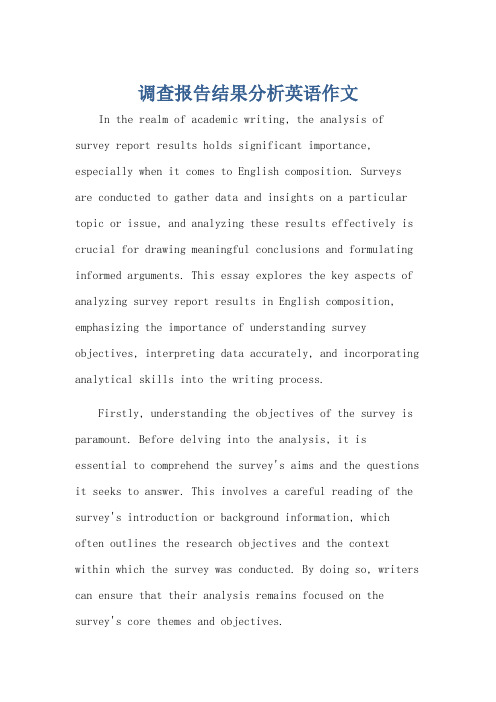
调查报告结果分析英语作文In the realm of academic writing, the analysis of survey report results holds significant importance, especially when it comes to English composition. Surveys are conducted to gather data and insights on a particular topic or issue, and analyzing these results effectively is crucial for drawing meaningful conclusions and formulating informed arguments. This essay explores the key aspects of analyzing survey report results in English composition, emphasizing the importance of understanding survey objectives, interpreting data accurately, and incorporating analytical skills into the writing process.Firstly, understanding the objectives of the survey is paramount. Before delving into the analysis, it isessential to comprehend the survey's aims and the questions it seeks to answer. This involves a careful reading of the survey's introduction or background information, which often outlines the research objectives and the context within which the survey was conducted. By doing so, writers can ensure that their analysis remains focused on the survey's core themes and objectives.Next, the interpretation of survey data is a crucial step. Survey reports typically present data in various forms, including tables, charts, and statistical summaries. It is essential to review these data carefully, noting patterns, trends, and any significant findings. It is also important to consider the reliability and validity of the data, taking into account factors such as sample size, sampling methods, and potential biases. By doing so,writers can ensure that their analysis is based on solid evidence and accurate information.Incorporating analytical skills into the writing process is essential for an effective analysis of survey report results. This involves critically evaluating the data, drawing insights and conclusions, and supporting these with evidence from the survey. Writers should avoid merely summarizing the data but instead focus on analyzing it to reveal deeper meanings and implications. This can be achieved by using analytical language, making comparisons and contrasts, and discussing potential causes and effects. Moreover, it is crucial to present the analysis in a clear and concise manner. Organizing the essay into logicalsections, such as an introduction outlining the survey's objectives, a main body discussing the data analysis, and a conclusion summarizing the findings, can help enhance readability and coherence. Additionally, using appropriate language and terminology, as well as avoiding jargon or technical language that may confuse the reader, isessential for effective communication.In conclusion, analyzing survey report results in English composition requires a combination of understanding survey objectives, accurate interpretation of data, and incorporation of analytical skills. By carefully evaluating the data, drawing meaningful insights, and presenting the analysis in a clear and concise manner, writers can produce effective and informative essays that contribute to the understanding of the survey's topic or issue.**调查报告结果分析英语作文**在学术写作领域,调查报告结果的分析在英语作文中占据重要地位。
USP38 通用章节目录中文
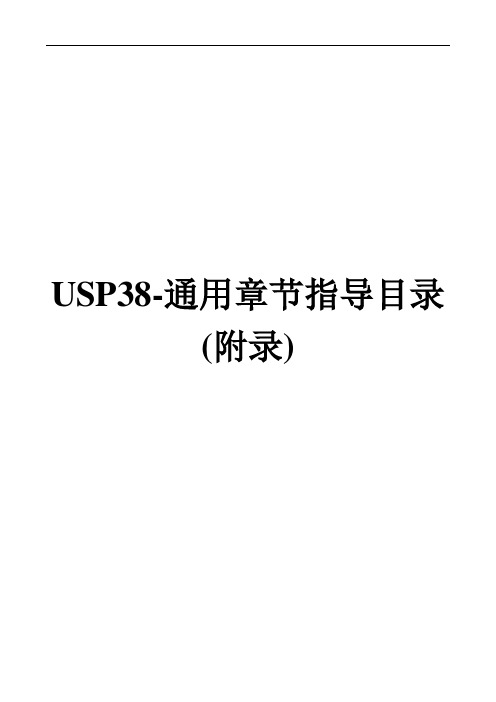
USP38-通用章节指导目录(附录)Guide to General Chapters 通用章节指导General Requirements for Test and Assays检查与含量分析的一般要求<1>INJECTIONS AND IMPLANTED DRUG PRODUCTS (PARENTERALS)—PRODUCT QUALITY TESTS 注射和植入药物产品(注射用) —产品质量测试<1>INJECTIONS注射剂<2>ORAL DRUG PRODUCTS—PRODUCT QUALITY TESTS 口服药物产品质量测试<3>TOPICAL AND TRANSDERMAL DRUG PRODUCTS—PRODUCT QUALITY TESTS 局部和透皮药物产品—产品质量测试<4>MUCOSAL DRUG PRODUCTS—PRODUCT QUALITY TESTS 粘膜药物产品质量测试<5>INHALATION AND NASAL DRUG PRODUCTS—GENERAL INFORMATION AND PRODUCT QUALITY TESTS 吸入剂产品—产品质量测试<7>LABELING 标签<11>USP REFERENCE STANDARDS USP标准品Apparatus for Test and Assays用于检查与含量分析的器具<17>PRESCRIPTION CONTAINER LABELING处方容器标签<21>THERMOMETERS温度计<31>VOLUMETRIC APPARATUS容量器具<41>BALANCES天平Microbiological Tests 微生物检查法<51>ANTIMICROBIAL EFFECTIVENESS TESTING抗菌剂有效性检查法<55>BIOLOGICAL INDICATORS—RESISTANCE PERFORMANCE TESTS生物指示剂-耐药性实验<61>MICROBIOLOGICAL EXAMINATION OF NONSTERILE PRODUCTS: MICROBIAL ENUMERATION TESTS非无菌产品的微生物限度检查:微生物列举检查法<62>MICROBIOLOGICAL EXAMINATION OF NONSTERILE PRODUCTS: TESTS FOR SPECIFIED MICROORGANISMS 非无菌产品的微生物限度检查:特定微生物检查法<63>MYCOPLASMA TESTS 支原体检查法<71>STERILITY TESTS无菌检查法Biological tests and assays生物检查法与测定法<81>ANTIBIOTICS—MICROBIAL ASSAYS抗生素-微生物测定<85>BACTERIAL ENDOTOXINS TEST细菌内毒素检查法<87>BIOLOGICAL REACTIVITY TESTS, IN VITRO体外的生物反应性检查法<88>BIOLOGICAL REACTIVITY TESTS, IN VIVO 体内的生物反应性检查法<89>ENZYMES USED AS ANCILLARY MATERIALS IN PHARMACEUTICAL MANUFACTURING 药品生产中酶作为辅料所使用<90>FETAL BOVINE SERUM—QUALITY ATTRIBUTES AND FUNCTIONALITY TESTS 牛胎儿血清-质量品质和功能检查法<91>CALCIUM PANTOTHENATE ASSAY泛酸钙测定法<92>GROWTH FACTORS AND CYTOKINES USED IN CELL THERAPY MANUFACTURING 在细胞疗法中使用生长因子和细胞因子<111>DESIGN AND ANALYSIS OF BIOLOGICAL ASSAYS 生物测定法的设计与分析<115>DEXPANTHENOL ASSAY右泛醇(拟胆碱药)测定法<121>INSULIN ASSAYS胰岛素测定法<121.1>PHYSICOCHEMICAL ANALYTICAL PROCEDURES FOR INSULINS胰岛素的物理化学分析程序<123>GLUCAGON BIOIDENTITY TESTS 高血糖素的生物鉴别检查法<124>ERYTHROPOIETIN BIOASSAYS 红细胞生成素的微生物测定<126>SOMATROPIN BIOIDENTITY TESTS 生长激素的生物鉴别检查法<130>PROTEIN A QUALITY ATTRIBUTES 蛋白质A的质量特征<151>PYROGEN TEST热原检查法<161>TRANSFUSION AND INFUSION ASSEMBLIES AND SIMILAR MEDICAL DEVICES 输血输液用具以及相类似的医疗器械<171>VITAMIN B12 ACTIVITY ASSAY……2548维生素B12活性测定法Chemical Tests and assays化学实验检查与测定法鉴别检查<181>IDENTIFICATION—ORGANIC NITROGENOUS BASES鉴别-有机氮碱化合物<191>IDENTIFICATION TESTS—GENERAL鉴别实验-通用<193>IDENTIFICATION—TETRACYCLINES鉴别-四环素类<197>SPECTROPHOTOMETRIC IDENTIFICATION TESTS分光光度计鉴别实验<201>THIN-LAYER CHROMATOGRAPHIC IDENTIFICATION TEST薄层色谱鉴别实验Limit Tests 限度检查法<206>ALUMINUM铝<207>TEST FOR 1,6-ANHYDRO DERIV ATIVE FOR ENOXAPARIN SODIUM依诺肝素钠的酐类衍生物实验<208>ANTI-FACTOR Xa AND ANTI-FACTOR IIa ASSAYS FOR UNFRACTIONATED AND LOW MOLECULAR WEIGHT HEPARINS普通肝素和低分子肝素产品中抗体Xa和抗体IIa测定<209>LOW MOLECULAR WEIGHT HEPARIN MOLECULAR WEIGHT DETERMINATIONS 低分子肝素钠分子量测定<211>ARSENIC砷<221>CHLORIDE AND SULFATE氯和硫<223>DIMETHYLANILINE二甲基苯胺<226>4-EPIANHYDRO-TETRACYCLINE4-?-四环素<227>4-AMINOPHENOL IN ACETAMINOPHEN-CONTAINING DRUG PRODUCTS 对乙酰氨酚药物产品中氨基酚<228>ETHYLENE OXIDE AND DIOXANE 环氧乙烷和二氧六环<231>HEA VY METALS重金属(删除)<232>ELEMENTAL IMPURITIES—LIMITS 元素杂质-限度<233>ELEMENTAL IMPURITIES—PROCEDURES 元素杂质-规程<241>IRON铁<251>LEAD铅<261>MERCURY汞<267>POROSIMETRY BY MERCURY INTRUSION 水银孔隙仪<268>POROSITY BY NITROGEN ADSORPTION–DESORPTION 氮吸附-解吸测定孔隙率<271>READILY CARBONIZABLE SUBSTANCES TEST易碳化物检查法<281>RESIDUE ON IGNITION炽灼残渣<291>SELENIUM硒Other Tests and Assays 其它检查法与测定法<301>ACID-NEUTRALIZING CAPACITY酸中和容量<311>ALGINATES ASSAY藻酸盐测定法<341>ANTIMICROBIAL AGENTS—CONTENT 抗菌剂-含量<345>Assay for Citric Acid/Citrate and Phosphate 柠檬酸/柠檬酸盐和磷酸盐的测定<351>ASSAY FOR STEROIDS类固醇(甾类化合物)测定法<361> BARBITURATE ASSAY 巴比妥类药物测定法<371>COBALAMIN RADIOTRACER ASSAY钴铵素放射性跟踪剂测定法<381>ELASTOMERIC CLOSURES FOR INJECTIONS 注射剂的弹性密封件<391>EPINEPHRINE ASSAY肾上腺素测定法<401>FATS AND FIXED OILS脂肪与混合油<411>FOLIC ACID ASSAY叶酸测定法<413>IMPURITIES TESTING IN MEDICAL GASES 医用气体杂质检查<415>MEDICAL GASES ASSAY 医用气体含量检查<425>IODOMETRIC ASSAY—ANTIBIOTICS碘量检查法-抗生素<429>LIGHT DIFFRACTION MEASUREMENT OF PARTICLE SIZE粒径的光衍射测量法<431>METHOXY DETERMINATION甲氧基测定法<441>NIACIN OR NIACINAMIDE ASSAY 烟酰或烟酰胺测定法<451>NITRITE TITRATION亚硝酸盐滴定<461>NITROGEN DETERMINATION氮测定法<466>ORDINARY IMPURITIES一般杂质<467>RESIDUAL SOLVENTS残留溶剂<469>ETHYLENE GLYCOL, DIETHYLENE GLYCOL, AND TRIETHYLENE GLYCOL IN ETHOXYLATED SUBSTANCES乙氧基物质中乙二醇、二甘醇、三甘醇测定<471>OXYGEN FLASK COMBUSTION氧瓶燃烧法<481>RIBOFLAVIN ASSAY核黄素(维生素B2)测定法<501>SALTS OF ORGANIC NITROGENOUS BASES有机氮盐<503>ACETIC ACID IN PEPTIDES 多肽类中乙酸测定<511>SINGLE-STEROID ASSAY单一的类固醇测定法<525>SULFUR DIOXIDE 二氧化硫<531>THIAMINE ASSAY硫胺素测定法<541>TITRIMETRY滴定法<551>VITAMIN E ASSAY维生素E测定法<561>ARTICLES OF BOTANICAL ORIGIN植物起源的药品<563>IDENTIFICATION OF ARTICLES OF BOTANICAL ORIGIN植物药品的鉴别<565>BOTANICAL EXTRACTS植物提取<571>VITAMIN A ASSAY维生素A测定法<581>VITAMIN D ASSAY维生素D测定法<591>ZINC DETERMINATION锌的测定法Physical Test and Determinations物理检查与测定法<601>INHALATION AND NASAL DRUG PRODUCTS: AEROSOLS, SPRAYS, AND POWDERS—PERFORMANCE QUALITY TESTS吸入剂、鼻雾剂:气溶胶,喷雾,干粉-质量通则<602>PROPELLANTS 推进剂<603>TOPICAL AEROSOLS 局部喷雾剂<604>LEAK RATE 渗漏率<610>ALTERNATIVE MICROBIOLOGICAL SAMPLING METHODS FOR NONSTERILE INHALED AND NASAL PRODUCTS非无菌吸入和鼻雾剂可供选择的微生物取样方法<611>ALCOHOL DETERMINATION乙醇测定法<616>BULK DENSITY AND TAPPED DENSITY堆密度与振实密度<621>CHROMATOGRAPHY色谱法<631>COLOR AND ACHROMICITY呈色与消色<641>COMPLETENESS OF SOLUTION溶解度<643>TOTAL ORGANIC CARBON总有机碳<645>W ATER CONDUCTIVITY水电导率<651>CONGEALING TEMPERATURE凝点温度<659>PACKAGING AND STORAGE REQUIREMENTS 包装和储藏要求<660>CONTAINERS—GLASS 容器-玻璃<661>CONTAINERS—PLASTICS容器-塑料<670>AUXILIARY PACKAGING COMPONENTS 辅助包装部件<671>CONTAINERS—PERFORMANCE TESTING容器-性能测试<691>COTTON棉花<695>CRYSTALLINITY结晶度<696>CHARACTERIZATION OF CRYSTALLINE SOLIDS BY MICROCALORIMETRY AND SOLUTION CALORIMETRY 通过溶液量热学测定结晶性<697>CONTAINER CONTENT FOR INJECTIONS 注射剂容器容积<698>DELIVERABLE VOLUME抽取体积<699>DENSITY OF SOLIDS固体密度<701>DISINTEGRATION崩解时限<705>QUALITY ATTRIBUTES OF TABLETS LABELED AS HA VING A FUNCTIONAL SCORE ?<711>DISSOLUTION 溶出度<721>DISTILLING RANGE馏程<724>DRUG RELEASE药物释放度<729>GLOBULE SIZE DISTRIBUTION IN LIPID INJECTABLE EMULSIONS脂类可注射的乳剂的粒径分布<730>Plasma Spectrochemistry 血浆光谱化学?<731>LOSS ON DRYING4干燥失重<733>LOSS ON IGNITION灼烧失重<735>X-RAY FLUORESCENCE SPECTROMETRY X射线光谱<736>MASS SPECTROMETRY 质谱<741>MELTING RANGE OR TEMPERATURE熔距或熔点<751>METAL PARTICLES IN OPHTHALMIC OINTMENTS眼用软膏中的金属粒子<755>MINIMUM FILL最低装量<761>NUCLEAR MAGNETIC RESONANCE核磁共振<771>OPHTHALMIC OINTMENTS眼用软膏<776>OPTICAL MICROSCOPY光学显微镜<781>OPTICAL ROTATION旋光度<785>OSMOLALITY AND OSMOLARITY渗透压<786>PARTICLE SIZE DISTRIBUTION ESTIMATION BY ANALYTICAL SIEVING 筛分法估算粒径分布<787>SUBVISIBLE PARTICULATE MATTER IN THERAPEUTIC PROTEIN INJECTIONS显微计数法在治疗性蛋白注射剂中应用<788>PARTICULATE MATTER IN INJECTIONS注射剂中的不溶性微粒<789>PARTICULATE MATTER IN OPHTHALMIC SOLUTIONS眼用溶液中的不溶性微粒<790>VISIBLE PARTICULATES IN INJECTIONS 注射剂中可见异物<791>pH<795>PHARMACEUTICAL COMPOUNDING—NONSTERILE PREPARATIONS药物混合-非无菌制剂<797>PHARMACEUTICAL COMPOUNDING—STERILE PREPARATIONS药物混合-无菌制剂<801>POLAROGRAPHY极谱法<811>POWDER FINENESS粉剂细度<821>RADIOACTIVITY放射性<823>POSITRON EMISSION TOMOGRAPHY DRUGS FOR COMPOUNDING, INVESTIGATIONAL, AND RESEARCH USES用于正电子发射断层造影术的放射性药物<831>REFRACTIVE INDEX折光率<841>SPECIFIC GRAVITY比重<846>SPECIFIC SURFACE AREA 比表面积<851>SPECTROPHOTOMETRY AND LIGHT-SCATTERING分光光度计与光散射<852>ATOMIC ABSORPTION SPECTROSCOPY 原子吸收光谱<853>FLUORESCENCE SPECTROSCOPY 荧光光谱<854>MID-INFRARED SPECTROSCOPY 中红外光谱<857>ULTRAVIOLET-VISIBLE SPECTROSCOPY 紫外可见光谱<861>SUTURES—DIAMETER缝线-直径?<871>SUTURES—NEEDLE ATTACHMENT缝线-穿孔实验<881>TENSILE STRENGTH张力<891>THERMAL ANALYSIS热分析<905>UNIFORMITY OF DOSAGE UNITS制剂单位的含量均匀度<911>VISCOSITY—CAPILLARY METHODS黏度-毛细管法<912>VISCOSITY—ROTATIONAL METHODS 黏度-旋转法<913>VISCOSITY—ROLLING BALL METHOD 黏度-球法<921>W ATER DETERMINATION水分测定<941>CHARACTERIZATION OF CRYSTALLINE AND PARTIALLY CRYSTALLINE SOLIDS BY X-RAY POWDER DIFFRACTION (XRPD)X光衍射General Information通用信息<1005>ACOUSTIC EMISSION 声频发射<1010>ANALYTICAL DATA—INTERPRETATION AND TREATMENT分析数据-解释与处理<1015>AUTOMATED RADIOCHEMICAL SYNTHESIS APPARATUS放射性自动合成装置<1024>BOVINE SERUM 牛血清<1027>FLOW CYTOMETRY 流式细胞仪<1030>BIOLOGICAL ASSAY CHAPTERS—OVERVIEW AND GLOSSARY生物测定章节-综述和术语<1031>THE BIOCOMPATIBILITY OF MATERIALS USED IN DRUG CONTAINERS, MEDICAL DEVICES, AND IMPLANTS用于药物容器、医疗设施和植入剂的材料的生物相容性<1034>ANALYSIS OF BIOLOGICAL ASSAYS 生物测定分析<1035>BIOLOGICAL INDICATORS FOR STERILIZATION灭菌用生物指示剂<1041>BIOLOGICS生物制剂<1043>Ancillary Material for Cell, Gene, and Tissue-Engineered Products细胞,基因与组织设计产品的辅助材料<1044>CRYOPRESERV ATION OF CELLS 细胞低温保存<1045>BIOTECHNOLOGY-DERIVED ARTICLES生物技术提取产品<1046>CELLULAR AND TISSUE-BASED PRODUCTS细胞与组织产品<1047>GENE THERAPY PRODUCTS 基因治疗产品<1048>QUALITY OF BIOTECHNOLOGICAL PRODUCTS: ANALYSIS OF THE EXPRESSION CONSTRUCT IN CELLS USED FOR PRODUCTION OF r-DNA DERIVED PROTEIN PRODUCTS 生物技术产品的质量:从蛋白质产品中提取的r-DNA产品在细胞中表达结构的分析<1049>QUALITY OF BIOTECHNOLOGICAL PRODUCTS: STABILITY TESTING OF BIOTECHNOLOGICAL/BIOLOGICAL PRODUCTS生物技术产品的质量:生物技术/生物产品的稳定性实验<1050>VIRAL SAFETY EV ALUATION OF BIOTECHNOLOGY PRODUCTS DERIVED FROM CELL LINES OF HUMAN OR ANIMAL ORIGIN从人或动物细胞中提取的生物技术产品的病毒安全性评估<1051>CLEANING GLASS APPARATUS玻璃容器的清洗<1052>BIOTECHNOLOGY-DERIVED ARTICLES—AMINO ACID ANALYSIS生物技术提取法-氨基酸测定<1053>CAPILLARY ELECTROPHORESIS 毛细管电泳法<1054>BIOTECHNOLOGY-DERIVED ARTICLES—ISOELECTRIC FOCUSING生物技术提取法-等电点聚集<1055>BIOTECHNOLOGY-DERIVED ARTICLES—PEPTIDE MAPPING生物技术提取法-肽谱<1056>BIOTECHNOLOGY-DERIVED ARTICLES—POLYACRYLAMIDE GEL ELECTROPHORESIS 生物技术提取法-凝胶电泳<1057>BIOTECHNOLOGY-DERIVED ARTICLES—TOTAL PROTEIN ASSAY生物技术提取法-总蛋白测定<1058>ANALYTICAL INSTRUMENT QUALIFICATION 分析仪器要求<1059>EXCIPIENT PERFORMANCE 赋形剂<1061>COLOR—INSTRUMENTAL MEASUREMENT显色-仪器测量<1065>Ion Chromatography 离子色谱法<1066>PHYSICAL ENVIRONMENTS THAT PROMOTE SAFE MEDICATION USE物理环境促使安全使用药物<1072>DISINFECTANTS AND ANTISEPTICS 消毒剂和防腐剂<1074>EXCIPIENT BIOLOGICAL SAFETY EV ALUATION GUIDELINES赋形剂(辅料)生物安全性评估指导<1078>GOOD MANUFACTURING PRACTICES FOR BULK PHARMACEUTICAL EXCIPIENTS 批药品赋形剂的生产管理规范<1079>Good Storage and Shipping Practices 良好的贮存与运输规范<1080>BULK PHARMACEUTICAL EXCIPIENTS—CERTIFICATE OF ANALYSIS批药品赋形剂-COA<1084>GLYCOPROTEIN AND GLYCAN ANALYSIS—GENERAL CONSIDERATIONS 糖蛋白和多糖分析-一般通则<1086>IMPURITIES IN DRUG SUBSTANCES AND DRUG PRODUCTS药物和药物产品中的杂质<1087>APPARENT INTRINSIC DISSOLUTION—DISSOLUTION TESTING PROCEDURES FOR ROTATING DISK AND STATIONARY DISK内部的溶出度-旋转和静止溶出检测程序?<1088>IN VITRO AND IN VIVO EV ALUATION OF DOSAGE FORMS体内与体外的剂型的评估<1090>ASSESSMENT OF DRUG PRODUCT PERFORMANCE-BIOAV AILABILITY, BIOEQUIV ALENCE, AND DISSOLUTION药物产品性能评估:生物利用度、生物等效性和溶出<1091>LABELING OF INACTIVE INGREDIENTS非活性成分的标示<1092>THE DISSOLUTION PROCEDURE: DEVELOPMENT AND V ALIDATION溶出程序:开发与验证<1094>CAPSULES—DISSOLUTION TESTING AND RELATED QUALITY ATTRIBUTES 胶囊-关于产品质量的溶出测定<1097>BULK POWDER SAMPLING PROCEDURES:粉末样品取样程序<1102>IMMUNOLOGICAL TEST METHODS—GENERAL CONSIDERATIONS免疫测试方法-总则<1103>IMMUNOLOGICAL TEST METHODS—ENZYME-LINKED IMMUNOSORBENT ASSAY (ELISA) 免疫学测试方法-酶联免疫吸附测定<1104>IMMUNOLOGICAL TEST METHODS—IMMUNOBLOT ANALYSIS免疫测试方法-免疫印迹法<1105>IMMUNOLOGICAL TEST METHODS—SURFACE PLASMON RESONANCE 免疫测试方法-表面等离子体共振<1106>IMMUNOGENICITY ASSAYS—DESIGN AND VALIDATION OF IMMUNOASSAYS TO DETECT ANTI-DRUG ANTIBODIES?<1111>MICROBIOLOGICAL EXAMINATION OF NONSTERILE PRODUCTS: ACCEPTANCE CRITERIA FOR PHARMACEUTICAL PREPARATIONS AND SUBSTANCES FOR PHARMACEUTICAL USE非无菌产品的微生物学检查:药用制剂和制药过程使用的物质接受标准<1112>MICROBIAL CHARACTERIZATION, IDENTIFICATION, AND STRAIN TYPING 非无菌药物产品水活性测定应用<1113>MICROBIOLOGICAL ATTRIBUTES OF NONSTERILE PHARMACEUTICAL PRODUCTS 非无菌药品中的微生物分布<1115>BIOBURDEN CONTROL OF NONSTERILE DRUG SUBSTANCES AND PRODUCTS 非无菌药物和产品的生物负载控制<1116>MICROBIOLOGICAL CONTROL AND MONITORING OF ASEPTIC PROCESSING ENVIRONMENTS洁净的房间与其它可控环境的微生物评估<1117>MICROBIOLOGICAL BEST LABORATORY PRACTICES 微生物最优实验室规范<1118>MONITORING DEVICES—TIME, TEMPERATURE, AND HUMIDITY监控装置-时间、温度与湿度<1119>NEAR-INFRARED SPECTROPHOTOMETRY近红外分光光度测定法<1120>Raman Spectrophotometry 拉曼分光光度测定法<1121>NOMENCLATURE命名<1125>NUCLEIC ACID-BASED TECHNIQUES—GENERAL 核酸技术-通则<1126>NUCLEIC ACID-BASED TECHNIQUES—EXTRACTION, DETECTION, AND SEQUENCING 核酸技术-提取、检测、测序<1127>NUCLEIC ACID-BASED TECHNIQUES—AMPLIFICATION 核酸技术-扩增<1128>NUCLEIC ACID-BASED TECHNIQUES—MICROARRAY 核酸技术-微阵列<1129>NUCLEIC ACID-BASED TECHNIQUES—GENOTYPING 核酸技术-基因分型<1130>NUCLEIC ACID-BASED TECHNIQUES—APPROACHES FOR DETECTING TRACE NUCLEIC ACIDS (RESIDUAL DNA TESTING)核酸技术-探测微量核酸的应用(残留DNA测试)<1136>PACKAGING AND REPACKAGING—SINGLE-UNIT CONTAINERS包装和再包装-单一容器<1151>PHARMACEUTICAL DOSAGE FORMS药物剂型<1152>ANIMAL DRUGS FOR USE IN ANIMAL FEEDS兽药在动物饲料中的使用<1160>PHARMACEUTICAL CALCULATIONS IN PRESCRIPTION COMPOUNDING 按处方混合的药物的计算<1163>QUALITY ASSURANCE IN PHARMACEUTICAL COMPOUNDING按处方混合的药物的质量保证<1171>PHASE-SOLUBILITY ANALYSIS相溶解分析<1174>Powder Flow 粉末流动性<1176>PRESCRIPTION BALANCES AND VOLUMETRIC APPARATUS 处方天平与容量器具<1177>Good Packaging Practices 良好的包装操作<1178>Good Repackaging Practices 良好的再包装操作<1180>HUMAN PLASMA 人血浆<1181>SCANNING ELECTRON MICROSCOPY扫描电子显微镜<1184>SENSITIZATION TESTING 致敏测试<1191>STABILITY CONSIDERATIONS IN DISPENSING PRACTICE分装操作中稳定性考察<1195>SIGNIFICANT CHANGE GUIDE FOR BULK PHARMACEUTICAL EXCIPIENTS 散装药用辅料更换指导原则<1197>GOOD DISTRIBUTION PRACTICES FOR BULK PHARMACEUTICAL EXCIPIENTS 散装药用辅料良好的分装操作<1207>STERILE PRODUCT PACKAGING—INTEGRITY EV ALUATION无菌产品包装-完整性评估<1208>STERILITY TESTING—V ALIDATION OF ISOLATOR SYSTEMS无菌实验-隔离系统的验证<1209>STERILIZATION—CHEMICAL AND PHYSICOCHEMICAL INDICATORS AND INTEGRATORS灭菌-化学与物理化学的指示剂以及二者的综合<1211>STERILIZATION AND STERILITY ASSURANCE OF COMPENDIAL ARTICLES 药典物品中的灭菌与灭菌保证<1216>TABLET FRIABILITY片剂的脆碎度<1217>TABLET BREAKING FORCE 片剂断裂力<1222>TERMINALLY STERILIZED PHARMACEUTICAL PRODUCTS—PARAMETRIC RELEASE 药品终端灭菌-放行参数<1223>V ALIDATION OF ALTERNATIVE MICROBIOLOGICAL METHODS可供选择的微生物学方法的验证<1224>TRANSFER OF ANALYTICAL PROCEDURES 分析方法转移<1225>V ALIDATION OF COMPENDIAL PROCEDURES药典方法的验证<1226>VERIFICATION OF COMPENDIAL PROCEDURES 药典方法的确认<1227>V ALIDATION OF MICROBIAL RECOVERY FROM PHARMACOPEIAL ARTICLES从药物中回收微生物的验证<1229>STERILIZATION OF COMPENDIAL ARTICLES 药典灭菌过程<1229.1>STEAM STERILIZATION BY DIRECT CONTACT 直接蒸汽灭菌<1229.2>MOIST HEAT STERILIZATION OF AQUEOUS LIQUIDS 水溶液的湿热灭菌<1229.3>MONITORING OF BIOBURDEN 生物负载监控<1229.4>STERILIZING FILTRATION OF LIQUIDS 溶液的无菌过滤器<1229.6>LIQUID-PHASE STERILIZATION 液态灭菌<1229.7>GASEOUS STERILIZATION 气态灭菌<1229.8>DRY HEAT STERILIZATION 干热灭菌<1229.10>RADIATION STERILIZATION 辐射灭菌<1230>W ATER FOR HEMODIALYSIS APPLICATIONS 血液透析过程用水<1231>W ATER FOR PHARMACEUTICAL PURPOSES制药用水<1234>VACCINES FOR HUMAN USE—POLYSACCHARIDE AND GLYCOCONJUGATE VACCINES 人用疫苗-多糖和糖复合物疫苗<1235>V ACCINES FOR HUMAN USE—GENERAL CONSIDERATIONS 人用疫苗-通则<1237>VIROLOGY TEST METHODS 病毒测试方法<1238>V ACCINES FOR HUMAN USE—BACTERIAL V ACCINES 人用疫苗-细菌疫苗<1240>VIRUS TESTING OF HUMAN PLASMA FOR FURTHER MANUFACTURE下一步使用人血浆的病毒测试<1241>W ATER–SOLID INTERACTIONS IN PHARMACEUTICAL SYSTEMS在药物系统中水与固体的相互作用<1251>WEIGHING ON AN ANALYTICAL BALANCE关于分析天平的称重<1265>Written Prescription Drug Information-Guidelines 书面的处方药信息-指南<1285>PREPARATION OF BIOLOGICAL SPECIMENS FOR HISTOLOGIC AND IMMUNOHISTOCHEMICAL ANALYSIS为了组织和免疫组织分析的生物标本制备<1285.1>HEMATOXYLIN AND EOSIN STAINING OF SECTIONED TISSUE FOR MICROSCOPIC EXAMINATION显微镜观察用苏木精和伊红染色的切片<1601>PRODUCTS FOR NEBULIZATION—CHARACTERIZATION TESTS 产品雾化状态-性状描述<1644>THEORY AND PRACTICE OF ELECTRICAL CONDUCTIVITY MEASUREMENTS OF SOLUTIONS溶液电导值测量方法的理论与实践<1660>EV ALUATION OF THE INNER SURFACE DURABILITY OF GLASS CONTAINERS 玻璃容器内表面耐久性评估<1724>SEMISOLID DRUG PRODUCTS—PERFORMANCE TESTS 半固态药物产品-性能测试<1736>APPLICATIONS OF MASS SPECTROMETRY 质谱应用<1761>APPLICATIONS OF NUCLEAR MAGNETIC RESONANCE SPECTROSCOPY核磁共振光谱应用<1787>MEASUREMENT OF SUBVISIBLE PARTICULATE MATTER IN THERAPEUTIC PROTEIN INJECTIONS用显微镜测量方法测量治疗性蛋白注射剂的不溶性微粒<1788>METHODS FOR THE DETERMINATION OF PARTICULATE MATTER IN INJECTIONS AND OPHTHALMIC SOLUTIONS注射剂和眼用溶液的不溶性微粒测定的方法选择<1852>ATOMIC ABSORPTION SPECTROSCOPY—THEORY AND PRACTICE原子吸收光谱-理论与实践<1853>FLUORESCENCE SPECTROSCOPY—THEORY AND PRACTICE荧光光谱-理论与实践<1854>MID-INFRARED SPECTROSCOPY—THEORY AND PRACTICE中红外光谱-理论与实践<1857>ULTRA VIOLET-VISIBLE SPECTROSCOPY—THEORY AND PRACTICE紫外可见光谱-理论与实践<1911>RHEOMETRY 流变测定Dietary Supplements营养补充剂General Tests and Assays 一般检查法与测定法<2021>MICROBIAL ENUMERATION TESTS—NUTRITIONAL AND DIETARY SUPPLEMENTS…3080微生物数量实验-营养与食品添加剂<2022>MICROBIOLOGICAL PROCEDURES FOR ABSENCE OF SPECIFIED MICROORGANISMS—NUTRITIONAL AND DIETARY SUPPLEMENTS (3083)不得检出特定微生物的程序-营养与营养补充剂<2023>MICROBIOLOGICAL ATTRIBUTES OF NONSTERILE NUTRITIONAL AND DIETARY SUPPLEMENTS……3087非无菌的营养与食品添加剂中的微生物分布<2040>DISINTEGRATION AND DISSOLUTION OF DIETARY SUPPLEMENTS (3089)食品添加剂的崩解与溶出<2091>WEIGHT V ARIATION OF DIETARY SUPPLEMENTS……3092食品添加剂的重量差异<2750>MANUFACTURING PRACTICES FOR DIETARY SUPPLEMENTS (3093)食品添加剂的生产操作。
美国药典2011-5-3

171 VITAMIN B12 ACTIVITY ASSAY
Chemical Tests and Assays
Identification Tests
18BASES 191 IDENTIFICATION TESTS-GENERAL 194 IDENTIFICATION-TETRACYCLINES 197 SPECTROPHOTOMETRIC IDENTIFICATION TESTS 201 THIN-LAYER CHROMATOGRAPHIC IDENTIFICATION TEST
651 CONGEALING TEMPERATURE 661 CONTAINERS 671 CONTAINERS-PERMEATION 691 COTTON 695 CRYSTALLINITY 698 DELIVERABLE VOLUME 699 DENSITY OF SOLIDS 701 DISINTEGRATION 711 DISSOLUTION 721 DISTILLING RANGE 724 DRUG RELEASE
)尚未收入的新药和新制剂。 美国药典最新版为USP34-NF29,2010 年12 月出版,2011年5月1日生效。
Introduction
Front Matter
General Notices General Chapters Dietary Supplements Chapters Reagents
Chart 9 Chart 10 Chart 11 Chart 12 Chart 13
General Tests and Assays
Physical Tests and Determinations
601 AEROSOLS, NASAL SPRAYS, METEREDDOSE INHALERS,AND DRY POWDER INHALERS 616 BULK DENSITY AND TAPPED DENSITY 621 CHROMATOGRAPHY 631 COLOR AND ACHROMICITY 641 COMPLETENESS OF SOLUTION 643 TOTAL ORGANIC CARBON 645 WATER CONDUCTIVITY
英语报告作文形式有哪些
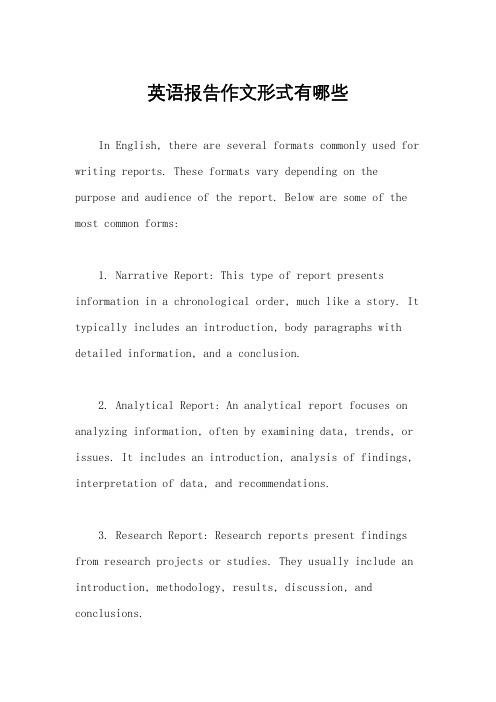
英语报告作文形式有哪些In English, there are several formats commonly used for writing reports. These formats vary depending on the purpose and audience of the report. Below are some of the most common forms:1. Narrative Report: This type of report presents information in a chronological order, much like a story. It typically includes an introduction, body paragraphs with detailed information, and a conclusion.2. Analytical Report: An analytical report focuses on analyzing information, often by examining data, trends, or issues. It includes an introduction, analysis of findings, interpretation of data, and recommendations.3. Research Report: Research reports present findings from research projects or studies. They usually include an introduction, methodology, results, discussion, and conclusions.4. Formal Report: Formal reports are structured documents used for conveying information to a specific audience, such as a company's stakeholders or government agencies. They typically include a title page, table of contents, executive summary, introduction, body sections, conclusions, recommendations, and appendices.5. Informal Report: Informal reports are less structured and often used for internal communication within organizations. They may include a brief introduction, main body with key points, and a conclusion.6. Progress Report: Progress reports provide updates on the status of a project or activity. They typically include information on what has been accomplished, any challenges encountered, and plans for the future.7. Feasibility Report: Feasibility reports assess the viability of a project or proposal. They usually include an introduction, background information, analysis of options, conclusions, and recommendations.8. Technical Report: Technical reports are used to convey technical information or findings. They ofteninclude detailed data, charts, graphs, and technical terminology.9. Financial Report: Financial reports provide information on an organization's financial performance.They typically include balance sheets, income statements, cash flow statements, and footnotes.10. Executive Summary: An executive summary is aconcise overview of the main points and findings of a report. It is often included at the beginning of a reportto provide busy readers with a quick summary of the content.These are just a few examples of the different types of report formats used in English. The specific format you choose will depend on the purpose of your report and the preferences of your audience.。
气相色谱仪气路流程上各部件的主要功能
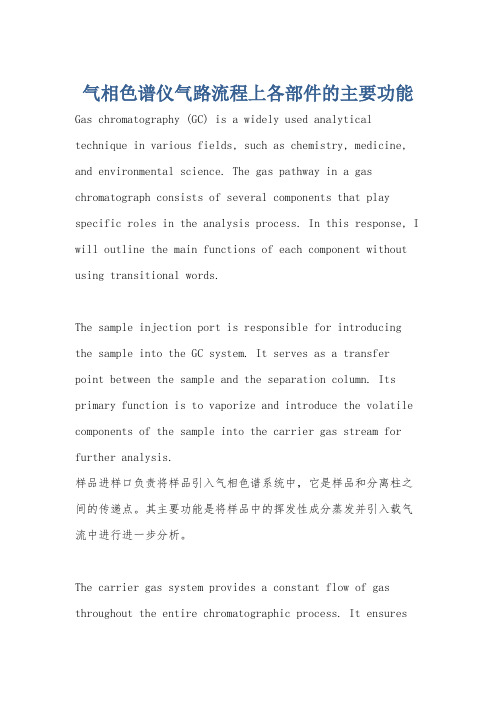
气相色谱仪气路流程上各部件的主要功能Gas chromatography (GC) is a widely used analytical technique in various fields, such as chemistry, medicine, and environmental science. The gas pathway in a gas chromatograph consists of several components that play specific roles in the analysis process. In this response, I will outline the main functions of each component without using transitional words.The sample injection port is responsible for introducing the sample into the GC system. It serves as a transfer point between the sample and the separation column. Its primary function is to vaporize and introduce the volatile components of the sample into the carrier gas stream for further analysis.样品进样口负责将样品引入气相色谱系统中,它是样品和分离柱之间的传递点。
其主要功能是将样品中的挥发性成分蒸发并引入载气流中进行进一步分析。
The carrier gas system provides a constant flow of gas throughout the entire chromatographic process. It ensuresthat the sample components are carried through the column efficiently. The carrier gas flows through various valves, regulators, and flow controllers to maintain a consistent and controlled flow rate.载气系统在整个色谱过程中提供稳定的气流,确保样品成分在柱内有效携带。
USP 通用章节目录-推荐下载
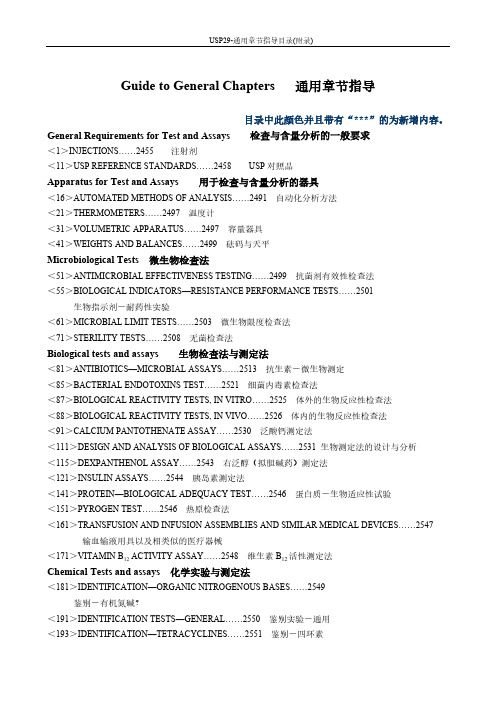
USP29-通用章节指导目录(附录)Guide to General Chapters 通用章节指导目录中此颜色并且带有“***”的为新增内容。
General Requirements for Test and Assays 检查与含量分析的一般要求<1>INJECTIONS……2455 注射剂<11>USP REFERENCE STANDARDS……2458 USP对照品Apparatus for Test and Assays 用于检查与含量分析的器具<16>AUTOMATED METHODS OF ANALYSIS……2491 自动化分析方法<21>THERMOMETERS……2497 温度计<31>VOLUMETRIC APPARATUS……2497 容量器具<41>WEIGHTS AND BALANCES……2499 砝码与天平Microbiological Tests 微生物检查法<51>ANTIMICROBIAL EFFECTIVENESS TESTING……2499 抗菌剂有效性检查法<55>BIOLOGICAL INDICATORS—RESISTANCE PERFORMANCE TESTS (2501)生物指示剂-耐药性实验<61>MICROBIAL LIMIT TESTS……2503 微生物限度检查法<71>STERILITY TESTS……2508 无菌检查法 Biological tests and assays 生物检查法与测定法<81>ANTIBIOTICS—MICROBIAL ASSAYS……2513 抗生素-微生物测定<85>BACTERIAL ENDOTOXINS TEST……2521 细菌内毒素检查法<87>BIOLOGICAL REACTIVITY TESTS, IN VITRO……2525 体外的生物反应性检查法<88>BIOLOGICAL REACTIVITY TESTS, IN VIVO……2526 体内的生物反应性检查法<91>CALCIUM PANTOTHENATE ASSAY……2530 泛酸钙测定法<111>DESIGN AND ANALYSIS OF BIOLOGICAL ASSAYS……2531 生物测定法的设计与分析<115>DEXPANTHENOL ASSAY……2543 右泛醇(拟胆碱药)测定法<121>INSULIN ASSAYS……2544 胰岛素测定法<141>PROTEIN—BIOLOGICAL ADEQUACY TEST……2546 蛋白质-生物适应性试验<151>PYROGEN TEST……2546 热原检查法<161>TRANSFUSION AND INFUSION ASSEMBLIES AND SIMILAR MEDICAL DEVICES (2547) 输血输液用具以及相类似的医疗器械<171>VITAMIN B12 ACTIVITY ASSAY……2548 维生素B12活性测定法Chemical Tests and assays 化学实验与测定法<181>IDENTIFICATION—ORGANIC NITROGENOUS BASES (2549)鉴别-有机氮碱?<191>IDENTIFICATION TESTS—GENERAL……2550 鉴别实验-通用<193>IDENTIFICATION—TETRACYCLINES……2551 鉴别-四环素<197>SPECTROPHOTOMETRIC IDENTIFICATION TESTS......2552 分光光度计鉴别实验<201>THIN-LAYER CHROMATOGRAPHIC IDENTIFICATION TEST.. (2553)薄层色谱鉴别实验Limit Test 限度检查法<206>ALUMINUM……2554 铝<211>ARSENIC……2554 砷<221>CHLORIDE AND SULFATE……2555 氯和硫<223>DIMETHYLANILINE……2555 二甲基苯胺<226>4-EPIANHYDRO-TETRACYCLINE……2556 4-?-四环素<231>HEAVY METALS……2556 重金属<241>IRON……2557 铁<251>LEAD……2558 铅<261>MERCURY……2558 汞<271>READILY CARBONIZABLE SUBSTANCES TEST……2560 易碳化物检查法<281>RESIDUE ON IGNITION……2560 灼烧残渣<291>SELENIUM……2560 硒Other Tests and Assays 其它检查法与测定法<301>ACID-NEUTRALIZING CAPACITY……2561 酸中和容量<311>ALGINATES ASSAY……2562 藻酸盐测定法<331>AMPHETAMINE ASSAY……2562 苯丙胺测定法<341> ANTIMICROBIAL AGENTS—CONTENT……2563 抗菌剂-含量<345> Assay for Citric Acid/Citrate and Phosphate……2565 柠檬酸/柠檬酸盐和磷酸盐的测定<351>ASSAY FOR STEROIDS……2565 类固醇(甾类化合物)测定法<361> BARBITURATE ASSAY……2565 巴比妥类药物测定法<371>COBALAMIN RADIOTRACER ASSAY……2566 钴铵素放射性跟踪剂测定法<381>ELASTOMERIC CLOSURES FOR INJECTIONS……2567 注射剂的弹性密封件<391>EPINEPHRINE ASSAY……2567 肾上腺测定法<401>FATS AND FIXED OILS……2568 脂肪与混合油<411>FOLIC ACID ASSAY……2571 叶酸测定法<425>IODOMETRIC ASSAY—ANTIBIOTICS……2572 碘量检查法-抗生素<429>LIGHT DIFFRACTION MEASUREMENT OF PARTICLE SIZE (2572)粒子尺寸的光衍射测量<431>METHOXY DETERMINATION……2575 甲氧基测定法<441>NIACIN OR NIACINAMIDE ASSAY……2576 烟酰或烟酰胺测定法<451>NITRITE TITRATION……2578 亚硝酸盐滴定<461>NITROGEN DETERMINATION……2578 氮测定法<466>ORDINARY IMPURITIES……2579 一般杂质<467>ORGANIC VOLATILE IMPURITIES……2580 有机的易挥发杂质<471>OXYGEN FLASK COMBUSTION……2590 氧瓶燃烧法<481>RIBOFLAVIN ASSAY……2590 核黄素测定法<501>SALTS OF ORGANIC NITROGENOUS BASES……2591 有机氮盐<511>SINGLE-STEROID ASSAY……2591 单一的类固醇测定法<521>SULFONAMIDES……2592 磺胺制剂<531>THIAMINE ASSAY……2593 硫胺素测定法<541>TITRIMETRY……2593 滴定法<551>ALPHA TOCOPHEROL ASSAY……2596 α-维生素E测定法<561>ARTICLES OF BOTANICAL ORIGIN……2596 植物起源的药品<563>IDENTIFICATION OF ARTICLES OF BOTANICAL ORIGIN……2603 植物药品的鉴别<565>BOTANICAL EXTRACTS……2609 植物提取<571>VITAMIN A ASSAY……2611 维生素A的测定法<581>VITAMIN D ASSAY……2612 维生素D的测定法<591>ZINC DETERMINATION……2616 锌的测定法Physical Test and Determinations 物理检查与测定法INHALERS, AND DRY POWDER <601>AEROSOLS, NASAL SPRAYS,USP28METERED-DOSEINHALERS……2617 气溶胶,鼻用喷雾剂,定量吸入器与干粉吸入器<611>ALCOHOL DETERMINATION……2637 乙醇测定法<616>BULK DENSITY AND TAPPED DENSITY……2638 堆密度与拍实密度<621>CHROMATOGRAPHY…….2639 色谱法<631>COLOR AND ACHROMICITY……2651 呈色与消色<641>COMPLETENESS OF SOLUTION……2652 完全溶解<643>TOTAL ORGANIC CARBON……2652 总有机碳<645>WATER CONDUCTIVITY……2653 水电导率<651>CONGEALING TEMPERATURE……2654 凝点温度<661>CONTAINERS……2655 容器<671>CONTAINERS—PERMEATION……2663 容器-渗透<691>COTTON……2664 棉花<695>CRYSTALLINITY……2665 结晶性<696>Crystallinity Determination By Solution Calorimetry……2666 通过溶液量热学测定结晶性<698>DELIVERABLE VOLUME……2667 可转移的体积<699>DENSITY OF SOLIDS……2669 固体密度<701>DISINTEGRATION……2670 崩解时限***<701>Disintegration (Harmonized Chapter, Official April 1,2006)………..2671 崩解时限(协调的章节,法定日期,2006.4.1)<711>DISSOLUTION……2673 溶出度***<711>Dissolution (Harmonized Chapter, Official April 1,2006)………..2675 溶出度(协调的章节,法定日期,2006.4.1)<721>DISTILLING RANGE……2682 馏程<724>DRUG RELEASE……2682 药物释放度***<724>Drug releasee (Harmonized Chapter, Official April 1,2006)………..2690 药物释放度(协调的章节,法定日期,2006.4.1)<726>ELECTROPHORESIS……2694 电泳 <727>CAPILLARY ELECTROPHORESIS……2696 毛细管电泳法***<730>Plasma Spectrochemistry….2700 血浆光谱化学<731>LOSS ON DRYING……2704 干燥失重<733>LOSS ON IGNITION……2704 灼烧失重<736>MASS SPECTROMETRY……2705 质谱<741>MELTING RANGE OR TEMPERATURE……2708 熔距或熔点<751>METAL PARTICLES IN OPHTHALMIC OINTMENTS……2709 眼用软膏中的金属粒子<755>MINIMUM FILL……2710 最低装填量<761>NUCLEAR MAGNETIC RESONANCE……2710 核磁共振<771>OPHTHALMIC OINTMENTS……2715 眼用软膏<776>OPTICAL MICROSCOPY……2716 光学显微镜<781>OPTICAL ROTATION……2718 旋光<785>OSMOLALITY AND OSMOLARITY……2718 同渗重摩与同渗容摩<786>PARTICLE SIZE DISTRIBUTION ESTIMATION BY ANALYTICAL SIEVING (2720) 通过筛分法估算粒子分布<788>PARTICULATE MATTER IN INJECTIONS……2722 注射剂中的颗粒<789>PARTICULATE MATTER IN OPHTHALMIC SOLUTIONS……2729 眼用溶液中的颗粒<791>pH (2730)<795>PHARMACEUTICAL COMPOUNDING—NONSTERILE PREPARATIONS (2731) 药物混合-非无菌制剂<797>PHARMACEUTICAL COMPOUNDING—STERILE PREPARATIONS (2735) 药物混合-无菌制剂<801>POLAROGRAPHY……2752 极谱法<811>POWDER FINENESS……2754 粉剂细度<821>RADIOACTIVITY……2755 放射性<823>RADIOPHARMACEUTICALS FOR POSITRON EMISSION TOMOGRAPHY —COMPOUNDING……2763 用于正电子发射断层摄影术的放射性药物<831>REFRACTIVE INDEX……2766 折光率<841>SPECIFIC GRAVITY……2766 比重<846>SPECIFIC SURFACE AREA……2767 比表面积<851>SPECTROPHOTOMETRY AND LIGHT-SCATTERING……2770 分光光度计与光散射<861>SUTURES—DIAMETER…2775 缝线-直径<871>SUTURES—NEEDLE ATTACHMENT……2775 缝线-穿孔实验<881>TENSILE STRENGTH…..2776 张力<891>THERMAL ANALYSIS……2776 热分析<905>UNIFORMITY OF DOSAGE UNITS……2778 制剂单位的含量均匀度<905>UNIFORMITY OF DOSAGE UNITS (Harmonized Chapter, Official April 1,2006)……2780 制剂单位的含量均匀度(协调的章节2006.4.1)<911>VISCOSITY……2785 粘度<921>WATER DETERMINATION……2785 水测定法<941>X-RAY DIFFRACTION……2788 X光衍射General Information 通用信息<1010>ANALYTICAL DATA—INTERPRETATION AND TREATMENT (2790)分析数据-解释与处理<1015>AUTOMATED RADIOCHEMICAL SYNTHESIS APPARATUS (2801) 放射性自动合成装置<1031>THE BIOCOMPATIBILITY OF MATERIALS USED IN DRUG CONTAINERS, MEDICAL DEVICES, AND IMPLANTS (2802)用于药物容器、医疗设施和植入剂的材料的生物相容性<1035>BIOLOGICAL INDICATORS FOR STERILIZATION……2811 灭菌用生物指示剂<1041>BIOLOGICS……2814 生物制剂***<1043>Ancillary Material for Cell, Gene, and Tissue-Engineered Products…….2814 细胞,基因与组织设计产品的辅助材料<1045>BIOTECHNOLOGY-DERIVED ARTICLES……2821 生物技术提取产品<1046>CELL AND GENE THERAPY PRODUCTS……2831 细胞与基因治疗产品<1047>BIOTECHNOLOGY-DERIVED ARTICLES—TESTS……2858 生物技术产品-检查法<1048>QUALITY OF BIOTECHNOLOGICAL PRODUCTS: ANALYSIS OF THE EXPRESSION CONSTRUCT IN CELLS USED FOR PRODUCTION OF r-DNA DERIVED PROTEIN PRODUCTS1 (2883)生物产品质量:从蛋白质产品中提取的r-DNA产品在细胞中表达结构的分析<1049>QUALITY OF BIOTECHNOLOGICAL PRODUCTS: STABILITY TESTING OF BIOTECHNOLOGICAL/BIOLOGICAL PRODUCTS1 (2884)生物技术产品的质量:生物技术/生物产品的稳定性实验<1050>VIRAL SAFETY EVALUATION OF BIOTECHNOLOGY PRODUCTS DERIVED FROM CELL LINES OF HUMAN OR ANIMAL ORIGIN (2887)从人或动物细胞中提取的生物技术产品的病毒安全性评估<1051>CLEANING GLASS APPARATUS……2896 玻璃容器的清洗<1061>COLOR—INSTRUMENTAL MEASUREMENT……2896 显色-仪器测量***<1065>Ion Chromatography………2898 离子色谱法<1074>EXCIPIENT BIOLOGICAL SAFETY EVALUATION GUIDELINES (2900) 赋形剂(辅料)生物安全性评估指导<1075>GOOD COMPOUNDING PRACTICES……2903 好的混合操作<1078>GOOD MANUFACTURING PRACTICES FOR BULK PHARMACEUTICAL EXCIPIENTS (2906)批药品赋形剂的生产管理规范***<1079>Good Storage and Shipping Practices……2915 良好的贮存与船运规范<1081>GEL STRENGTH OF GELATIN……2920 白凝胶的凝胶强度<1086>IMPURITIES IN OFFICIAL ARTICLES……2920 药典物品中的杂质<1087>INTRINSIC DISSOLUTION……2923 内部的溶出度<1088>IN VITRO AND IN VIVO EVALUATION OF DOSAGE FORMS (2924) 体内与体外的剂型的评估<1090>IN VIVO BIOEQUIVALENCE GUIDANCES……29291 体内生物等效性指导<1091>LABELING OF INACTIVE INGREDIENTS……2968 非活性成分的标示<1101>MEDICINE DROPPER……2969 医用滴管<1111>MICROBIOLOGICAL ATTRIBUTES OF NONSTERILE PHARMACEUTICAL PRODUCTS (2969)非无菌药品中的微生物分布<1116>MICROBIOLOGICAL EVALUATION OF CLEAN ROOMS AND OTHER CONTROLLED ENVIRONMENTS……2969 洁净的房间与其它可控环境的微生物评估<1118>MONITORING DEVICES—TIME, TEMPERATURE, AND HUMIDITY (2976)监控装置-时间、温度与湿度<1119>NEAR-INFRARED SPECTROPHOTOMETRY……2979 近红外分光光度测定法***<1120>Raman Spectrophotometry……..2983 Raman分光光度测定法<1121>NOMENCLATURE……2988 命名***<1136>Packaging-Unit-of-Use……2989 包装-单元使用<1146>PACKAGING PRACTICE—REPACKAGING A SINGLE SOLID ORAL DRUG PRODUCT INTO A UNIT-DOSE CONTAINER……2990 包装操作-将单一固体口服药品产品再包装成单元剂量<1150>PHARMACEUTICAL STABILITY……2994 药物稳定性<1151>PHARMACEUTICAL DOSAGE FORMS……2996 药物剂型<1160>PHARMACEUTICAL CALCULATIONS IN PRESCRIPTION COMPOUNDING (3006) 按处方混合的药物的计算<1171>PHASE-SOLUBILITY ANALYSIS……3016 相溶解分析***<1174>Powder Flow….3017 粉末流动性<1176>PRESCRIPTION BALANCES AND VOLUMETRIC APPARATUS….3020 处方天平与容量器具***<1177>Good Packaging Practices….3021 良好的包装操作***<1178>Good Repackaging Practices….3023 良好的再包装操作<1181>SCANNING ELECTRON MICROSCOPY……3025 扫描电子显微镜<1191>STABILITY CONSIDERATIONS IN DISPENSING PRACTICE……3029 分装操作中稳定性考察<1196>PHARMACOPEIAL HARMONIZATION……3031 药典的一致性<1207>STERILE PRODUCT PACKAGING—INTEGRITY EVALUATION (3035) 无菌产品包装-完整性评估<1208>STERILITY TESTING—VALIDATION OF ISOLATOR SYSTEMS (3037) 无菌实验-隔离系统的验证<1209>STERILIZATION—CHEMICAL AND PHYSICOCHEMICAL INDICATORS AND INTEGRATORS……3040 灭菌-化学与物理化学的指示剂以及二者的综合<1211>STERILIZATION AND STERILITY ASSURANCE OF COMPENDIAL ARTICLES (3041)药典物品中的灭菌与灭菌保证<1216>TABLET FRIABILITY……3046 片剂的脆碎度<1221>TEASPOON……3047 茶匙<1222>TERMINALLY STERILIZED PHARMACEUTICAL PRODUCTS—PARAMETRIC RELEASE……3047 最终灭菌产品-放行参数<1225>VALIDATION OF COMPENDIAL METHODS……3050 药典方法的验证<1227>VALIDATION OF MICROBIAL RECOVERY FROM PHARMACOPEIAL ARTICLES (3053) 从药物中回收微生物的验证<1230>WATER FOR HEALTH APPLICATIONS……3055 健康用水<1231>WATER FOR PHARMACEUTICAL PURPOSES……3056 制药用水<1241>WATER–SOLID INTERACTIONS IN PHARMACEUTICAL SYSTEMS (3074) 在药物系统中水与固体的相互作用<1251>WEIGHING ON AN ANALYTICAL BALANCE……3076 关于分析天平的称重***<1265>Written Prescription Drug Information-Guidelines……….3078 书面的处方药信息-指南Dietary Supplements 营养补充剂General Tests and Assays 一般检查法与测定法<2021>MICROBIAL ENUMERATION TESTS—NUTRITIONAL AND DIETARY SUPPLEMENTS (3080)微生物数量实验-营养与食品添加剂<2022>MICROBIOLOGICAL PROCEDURES FOR ABSENCE OF SPECIFIED MICROORGANISMS—NUTRITIONAL AND DIETARY SUPPLEMENTS (3083)不得检出特定微生物的程序-营养与营养补充剂<2023>MICROBIOLOGICAL ATTRIBUTES OF NONSTERILE NUTRITIONAL AND DIETARY SUPPLEMENTS……3087 非无菌的营养与食品添加剂中的微生物分布<2040>DISINTEGRATION AND DISSOLUTION OF DIETARY SUPPLEMENTS (3089) 食品添加剂的崩解与溶出<2091>WEIGHT VARIATION OF DIETARY SUPPLEMENTS……3092 食品添加剂的重量差异<2750>MANUFACTURING PRACTICES FOR DIETARY SUPPLEMENTS (3093) 食品添加剂的生产操作。
【免费下载】USP 通用章节目录
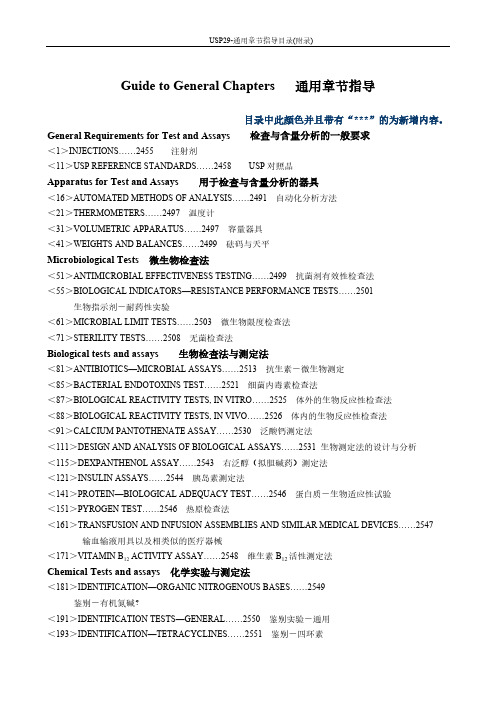
USP29-通用章节指导目录(附录)Guide to General Chapters 通用章节指导目录中此颜色并且带有“***”的为新增内容。
General Requirements for Test and Assays 检查与含量分析的一般要求<1>INJECTIONS……2455 注射剂<11>USP REFERENCE STANDARDS……2458 USP对照品Apparatus for Test and Assays 用于检查与含量分析的器具<16>AUTOMATED METHODS OF ANALYSIS……2491 自动化分析方法<21>THERMOMETERS……2497 温度计<31>VOLUMETRIC APPARATUS……2497 容量器具<41>WEIGHTS AND BALANCES……2499 砝码与天平Microbiological Tests 微生物检查法<51>ANTIMICROBIAL EFFECTIVENESS TESTING……2499 抗菌剂有效性检查法<55>BIOLOGICAL INDICATORS—RESISTANCE PERFORMANCE TESTS (2501)生物指示剂-耐药性实验<61>MICROBIAL LIMIT TESTS……2503 微生物限度检查法<71>STERILITY TESTS……2508 无菌检查法 Biological tests and assays 生物检查法与测定法<81>ANTIBIOTICS—MICROBIAL ASSAYS……2513 抗生素-微生物测定<85>BACTERIAL ENDOTOXINS TEST……2521 细菌内毒素检查法<87>BIOLOGICAL REACTIVITY TESTS, IN VITRO……2525 体外的生物反应性检查法<88>BIOLOGICAL REACTIVITY TESTS, IN VIVO……2526 体内的生物反应性检查法<91>CALCIUM PANTOTHENATE ASSAY……2530 泛酸钙测定法<111>DESIGN AND ANALYSIS OF BIOLOGICAL ASSAYS……2531 生物测定法的设计与分析<115>DEXPANTHENOL ASSAY……2543 右泛醇(拟胆碱药)测定法<121>INSULIN ASSAYS……2544 胰岛素测定法<141>PROTEIN—BIOLOGICAL ADEQUACY TEST……2546 蛋白质-生物适应性试验<151>PYROGEN TEST……2546 热原检查法<161>TRANSFUSION AND INFUSION ASSEMBLIES AND SIMILAR MEDICAL DEVICES (2547) 输血输液用具以及相类似的医疗器械<171>VITAMIN B12 ACTIVITY ASSAY……2548 维生素B12活性测定法Chemical Tests and assays 化学实验与测定法<181>IDENTIFICATION—ORGANIC NITROGENOUS BASES (2549)鉴别-有机氮碱?<191>IDENTIFICATION TESTS—GENERAL……2550 鉴别实验-通用<193>IDENTIFICATION—TETRACYCLINES……2551 鉴别-四环素<197>SPECTROPHOTOMETRIC IDENTIFICATION TESTS......2552 分光光度计鉴别实验<201>THIN-LAYER CHROMATOGRAPHIC IDENTIFICATION TEST.. (2553)薄层色谱鉴别实验Limit Test 限度检查法<206>ALUMINUM……2554 铝<211>ARSENIC……2554 砷<221>CHLORIDE AND SULFATE……2555 氯和硫<223>DIMETHYLANILINE……2555 二甲基苯胺<226>4-EPIANHYDRO-TETRACYCLINE……2556 4-?-四环素<231>HEAVY METALS……2556 重金属<241>IRON……2557 铁<251>LEAD……2558 铅<261>MERCURY……2558 汞<271>READILY CARBONIZABLE SUBSTANCES TEST……2560 易碳化物检查法<281>RESIDUE ON IGNITION……2560 灼烧残渣<291>SELENIUM……2560 硒Other Tests and Assays 其它检查法与测定法<301>ACID-NEUTRALIZING CAPACITY……2561 酸中和容量<311>ALGINATES ASSAY……2562 藻酸盐测定法<331>AMPHETAMINE ASSAY……2562 苯丙胺测定法<341> ANTIMICROBIAL AGENTS—CONTENT……2563 抗菌剂-含量<345> Assay for Citric Acid/Citrate and Phosphate……2565 柠檬酸/柠檬酸盐和磷酸盐的测定<351>ASSAY FOR STEROIDS……2565 类固醇(甾类化合物)测定法<361> BARBITURATE ASSAY……2565 巴比妥类药物测定法<371>COBALAMIN RADIOTRACER ASSAY……2566 钴铵素放射性跟踪剂测定法<381>ELASTOMERIC CLOSURES FOR INJECTIONS……2567 注射剂的弹性密封件<391>EPINEPHRINE ASSAY……2567 肾上腺测定法<401>FATS AND FIXED OILS……2568 脂肪与混合油<411>FOLIC ACID ASSAY……2571 叶酸测定法<425>IODOMETRIC ASSAY—ANTIBIOTICS……2572 碘量检查法-抗生素<429>LIGHT DIFFRACTION MEASUREMENT OF PARTICLE SIZE (2572)粒子尺寸的光衍射测量<431>METHOXY DETERMINATION……2575 甲氧基测定法<441>NIACIN OR NIACINAMIDE ASSAY……2576 烟酰或烟酰胺测定法<451>NITRITE TITRATION……2578 亚硝酸盐滴定<461>NITROGEN DETERMINATION……2578 氮测定法<466>ORDINARY IMPURITIES……2579 一般杂质<467>ORGANIC VOLATILE IMPURITIES……2580 有机的易挥发杂质<471>OXYGEN FLASK COMBUSTION……2590 氧瓶燃烧法<481>RIBOFLAVIN ASSAY……2590 核黄素测定法<501>SALTS OF ORGANIC NITROGENOUS BASES……2591 有机氮盐<511>SINGLE-STEROID ASSAY……2591 单一的类固醇测定法<521>SULFONAMIDES……2592 磺胺制剂<531>THIAMINE ASSAY……2593 硫胺素测定法<541>TITRIMETRY……2593 滴定法<551>ALPHA TOCOPHEROL ASSAY……2596 α-维生素E测定法<561>ARTICLES OF BOTANICAL ORIGIN……2596 植物起源的药品<563>IDENTIFICATION OF ARTICLES OF BOTANICAL ORIGIN……2603 植物药品的鉴别<565>BOTANICAL EXTRACTS……2609 植物提取<571>VITAMIN A ASSAY……2611 维生素A的测定法<581>VITAMIN D ASSAY……2612 维生素D的测定法<591>ZINC DETERMINATION……2616 锌的测定法Physical Test and Determinations 物理检查与测定法INHALERS, AND DRY POWDER <601>AEROSOLS, NASAL SPRAYS,USP28METERED-DOSEINHALERS……2617 气溶胶,鼻用喷雾剂,定量吸入器与干粉吸入器<611>ALCOHOL DETERMINATION……2637 乙醇测定法<616>BULK DENSITY AND TAPPED DENSITY……2638 堆密度与拍实密度<621>CHROMATOGRAPHY…….2639 色谱法<631>COLOR AND ACHROMICITY……2651 呈色与消色<641>COMPLETENESS OF SOLUTION……2652 完全溶解<643>TOTAL ORGANIC CARBON……2652 总有机碳<645>WATER CONDUCTIVITY……2653 水电导率<651>CONGEALING TEMPERATURE……2654 凝点温度<661>CONTAINERS……2655 容器<671>CONTAINERS—PERMEATION……2663 容器-渗透<691>COTTON……2664 棉花<695>CRYSTALLINITY……2665 结晶性<696>Crystallinity Determination By Solution Calorimetry……2666 通过溶液量热学测定结晶性<698>DELIVERABLE VOLUME……2667 可转移的体积<699>DENSITY OF SOLIDS……2669 固体密度<701>DISINTEGRATION……2670 崩解时限***<701>Disintegration (Harmonized Chapter, Official April 1,2006)………..2671 崩解时限(协调的章节,法定日期,2006.4.1)<711>DISSOLUTION……2673 溶出度***<711>Dissolution (Harmonized Chapter, Official April 1,2006)………..2675 溶出度(协调的章节,法定日期,2006.4.1)<721>DISTILLING RANGE……2682 馏程<724>DRUG RELEASE……2682 药物释放度***<724>Drug releasee (Harmonized Chapter, Official April 1,2006)………..2690 药物释放度(协调的章节,法定日期,2006.4.1)<726>ELECTROPHORESIS……2694 电泳 <727>CAPILLARY ELECTROPHORESIS……2696 毛细管电泳法***<730>Plasma Spectrochemistry….2700 血浆光谱化学<731>LOSS ON DRYING……2704 干燥失重<733>LOSS ON IGNITION……2704 灼烧失重<736>MASS SPECTROMETRY……2705 质谱<741>MELTING RANGE OR TEMPERATURE……2708 熔距或熔点<751>METAL PARTICLES IN OPHTHALMIC OINTMENTS……2709 眼用软膏中的金属粒子<755>MINIMUM FILL……2710 最低装填量<761>NUCLEAR MAGNETIC RESONANCE……2710 核磁共振<771>OPHTHALMIC OINTMENTS……2715 眼用软膏<776>OPTICAL MICROSCOPY……2716 光学显微镜<781>OPTICAL ROTATION……2718 旋光<785>OSMOLALITY AND OSMOLARITY……2718 同渗重摩与同渗容摩<786>PARTICLE SIZE DISTRIBUTION ESTIMATION BY ANALYTICAL SIEVING (2720) 通过筛分法估算粒子分布<788>PARTICULATE MATTER IN INJECTIONS……2722 注射剂中的颗粒<789>PARTICULATE MATTER IN OPHTHALMIC SOLUTIONS……2729 眼用溶液中的颗粒<791>pH (2730)<795>PHARMACEUTICAL COMPOUNDING—NONSTERILE PREPARATIONS (2731) 药物混合-非无菌制剂<797>PHARMACEUTICAL COMPOUNDING—STERILE PREPARATIONS (2735) 药物混合-无菌制剂<801>POLAROGRAPHY……2752 极谱法<811>POWDER FINENESS……2754 粉剂细度<821>RADIOACTIVITY……2755 放射性<823>RADIOPHARMACEUTICALS FOR POSITRON EMISSION TOMOGRAPHY —COMPOUNDING……2763 用于正电子发射断层摄影术的放射性药物<831>REFRACTIVE INDEX……2766 折光率<841>SPECIFIC GRAVITY……2766 比重<846>SPECIFIC SURFACE AREA……2767 比表面积<851>SPECTROPHOTOMETRY AND LIGHT-SCATTERING……2770 分光光度计与光散射<861>SUTURES—DIAMETER…2775 缝线-直径<871>SUTURES—NEEDLE ATTACHMENT……2775 缝线-穿孔实验<881>TENSILE STRENGTH…..2776 张力<891>THERMAL ANALYSIS……2776 热分析<905>UNIFORMITY OF DOSAGE UNITS……2778 制剂单位的含量均匀度<905>UNIFORMITY OF DOSAGE UNITS (Harmonized Chapter, Official April 1,2006)……2780 制剂单位的含量均匀度(协调的章节2006.4.1)<911>VISCOSITY……2785 粘度<921>WATER DETERMINATION……2785 水测定法<941>X-RAY DIFFRACTION……2788 X光衍射General Information 通用信息<1010>ANALYTICAL DATA—INTERPRETATION AND TREATMENT (2790)分析数据-解释与处理<1015>AUTOMATED RADIOCHEMICAL SYNTHESIS APPARATUS (2801) 放射性自动合成装置<1031>THE BIOCOMPATIBILITY OF MATERIALS USED IN DRUG CONTAINERS, MEDICAL DEVICES, AND IMPLANTS (2802)用于药物容器、医疗设施和植入剂的材料的生物相容性<1035>BIOLOGICAL INDICATORS FOR STERILIZATION……2811 灭菌用生物指示剂<1041>BIOLOGICS……2814 生物制剂***<1043>Ancillary Material for Cell, Gene, and Tissue-Engineered Products…….2814 细胞,基因与组织设计产品的辅助材料<1045>BIOTECHNOLOGY-DERIVED ARTICLES……2821 生物技术提取产品<1046>CELL AND GENE THERAPY PRODUCTS……2831 细胞与基因治疗产品<1047>BIOTECHNOLOGY-DERIVED ARTICLES—TESTS……2858 生物技术产品-检查法<1048>QUALITY OF BIOTECHNOLOGICAL PRODUCTS: ANALYSIS OF THE EXPRESSION CONSTRUCT IN CELLS USED FOR PRODUCTION OF r-DNA DERIVED PROTEIN PRODUCTS1 (2883)生物产品质量:从蛋白质产品中提取的r-DNA产品在细胞中表达结构的分析<1049>QUALITY OF BIOTECHNOLOGICAL PRODUCTS: STABILITY TESTING OF BIOTECHNOLOGICAL/BIOLOGICAL PRODUCTS1 (2884)生物技术产品的质量:生物技术/生物产品的稳定性实验<1050>VIRAL SAFETY EVALUATION OF BIOTECHNOLOGY PRODUCTS DERIVED FROM CELL LINES OF HUMAN OR ANIMAL ORIGIN (2887)从人或动物细胞中提取的生物技术产品的病毒安全性评估<1051>CLEANING GLASS APPARATUS……2896 玻璃容器的清洗<1061>COLOR—INSTRUMENTAL MEASUREMENT……2896 显色-仪器测量***<1065>Ion Chromatography………2898 离子色谱法<1074>EXCIPIENT BIOLOGICAL SAFETY EVALUATION GUIDELINES (2900) 赋形剂(辅料)生物安全性评估指导<1075>GOOD COMPOUNDING PRACTICES……2903 好的混合操作<1078>GOOD MANUFACTURING PRACTICES FOR BULK PHARMACEUTICAL EXCIPIENTS (2906)批药品赋形剂的生产管理规范***<1079>Good Storage and Shipping Practices……2915 良好的贮存与船运规范<1081>GEL STRENGTH OF GELATIN……2920 白凝胶的凝胶强度<1086>IMPURITIES IN OFFICIAL ARTICLES……2920 药典物品中的杂质<1087>INTRINSIC DISSOLUTION……2923 内部的溶出度<1088>IN VITRO AND IN VIVO EVALUATION OF DOSAGE FORMS (2924) 体内与体外的剂型的评估<1090>IN VIVO BIOEQUIVALENCE GUIDANCES……29291 体内生物等效性指导<1091>LABELING OF INACTIVE INGREDIENTS……2968 非活性成分的标示<1101>MEDICINE DROPPER……2969 医用滴管<1111>MICROBIOLOGICAL ATTRIBUTES OF NONSTERILE PHARMACEUTICAL PRODUCTS (2969)非无菌药品中的微生物分布<1116>MICROBIOLOGICAL EVALUATION OF CLEAN ROOMS AND OTHER CONTROLLED ENVIRONMENTS……2969 洁净的房间与其它可控环境的微生物评估<1118>MONITORING DEVICES—TIME, TEMPERATURE, AND HUMIDITY (2976)监控装置-时间、温度与湿度<1119>NEAR-INFRARED SPECTROPHOTOMETRY……2979 近红外分光光度测定法***<1120>Raman Spectrophotometry……..2983 Raman分光光度测定法<1121>NOMENCLATURE……2988 命名***<1136>Packaging-Unit-of-Use……2989 包装-单元使用<1146>PACKAGING PRACTICE—REPACKAGING A SINGLE SOLID ORAL DRUG PRODUCT INTO A UNIT-DOSE CONTAINER……2990 包装操作-将单一固体口服药品产品再包装成单元剂量<1150>PHARMACEUTICAL STABILITY……2994 药物稳定性<1151>PHARMACEUTICAL DOSAGE FORMS……2996 药物剂型<1160>PHARMACEUTICAL CALCULATIONS IN PRESCRIPTION COMPOUNDING (3006) 按处方混合的药物的计算<1171>PHASE-SOLUBILITY ANALYSIS……3016 相溶解分析***<1174>Powder Flow….3017 粉末流动性<1176>PRESCRIPTION BALANCES AND VOLUMETRIC APPARATUS….3020 处方天平与容量器具***<1177>Good Packaging Practices….3021 良好的包装操作***<1178>Good Repackaging Practices….3023 良好的再包装操作<1181>SCANNING ELECTRON MICROSCOPY……3025 扫描电子显微镜<1191>STABILITY CONSIDERATIONS IN DISPENSING PRACTICE……3029 分装操作中稳定性考察<1196>PHARMACOPEIAL HARMONIZATION……3031 药典的一致性<1207>STERILE PRODUCT PACKAGING—INTEGRITY EVALUATION (3035) 无菌产品包装-完整性评估<1208>STERILITY TESTING—VALIDATION OF ISOLATOR SYSTEMS (3037) 无菌实验-隔离系统的验证<1209>STERILIZATION—CHEMICAL AND PHYSICOCHEMICAL INDICATORS AND INTEGRATORS……3040 灭菌-化学与物理化学的指示剂以及二者的综合<1211>STERILIZATION AND STERILITY ASSURANCE OF COMPENDIAL ARTICLES (3041)药典物品中的灭菌与灭菌保证<1216>TABLET FRIABILITY……3046 片剂的脆碎度<1221>TEASPOON……3047 茶匙<1222>TERMINALLY STERILIZED PHARMACEUTICAL PRODUCTS—PARAMETRIC RELEASE……3047 最终灭菌产品-放行参数<1225>VALIDATION OF COMPENDIAL METHODS……3050 药典方法的验证<1227>VALIDATION OF MICROBIAL RECOVERY FROM PHARMACOPEIAL ARTICLES (3053) 从药物中回收微生物的验证<1230>WATER FOR HEALTH APPLICATIONS……3055 健康用水<1231>WATER FOR PHARMACEUTICAL PURPOSES……3056 制药用水<1241>WATER–SOLID INTERACTIONS IN PHARMACEUTICAL SYSTEMS (3074) 在药物系统中水与固体的相互作用<1251>WEIGHING ON AN ANALYTICAL BALANCE……3076 关于分析天平的称重***<1265>Written Prescription Drug Information-Guidelines……….3078 书面的处方药信息-指南Dietary Supplements 营养补充剂General Tests and Assays 一般检查法与测定法<2021>MICROBIAL ENUMERATION TESTS—NUTRITIONAL AND DIETARY SUPPLEMENTS (3080)微生物数量实验-营养与食品添加剂<2022>MICROBIOLOGICAL PROCEDURES FOR ABSENCE OF SPECIFIED MICROORGANISMS—NUTRITIONAL AND DIETARY SUPPLEMENTS (3083)不得检出特定微生物的程序-营养与营养补充剂<2023>MICROBIOLOGICAL ATTRIBUTES OF NONSTERILE NUTRITIONAL AND DIETARY SUPPLEMENTS……3087 非无菌的营养与食品添加剂中的微生物分布<2040>DISINTEGRATION AND DISSOLUTION OF DIETARY SUPPLEMENTS (3089) 食品添加剂的崩解与溶出<2091>WEIGHT VARIATION OF DIETARY SUPPLEMENTS……3092 食品添加剂的重量差异<2750>MANUFACTURING PRACTICES FOR DIETARY SUPPLEMENTS (3093) 食品添加剂的生产操作。
analytical essay英语作文
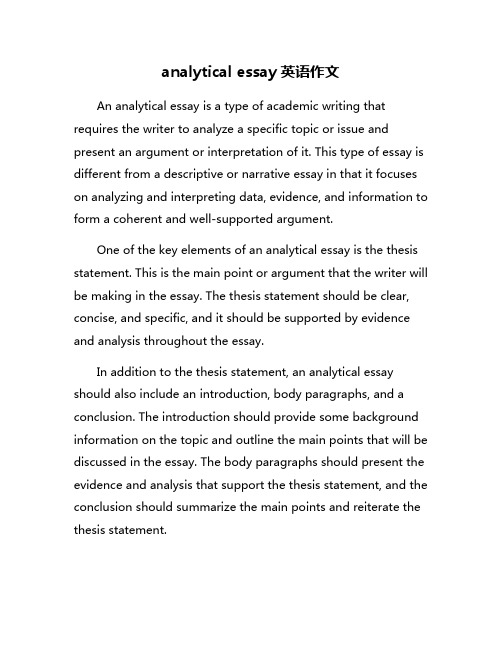
analytical essay英语作文An analytical essay is a type of academic writing that requires the writer to analyze a specific topic or issue and present an argument or interpretation of it. This type of essay is different from a descriptive or narrative essay in that it focuses on analyzing and interpreting data, evidence, and information to form a coherent and well-supported argument.One of the key elements of an analytical essay is the thesis statement. This is the main point or argument that the writer will be making in the essay. The thesis statement should be clear, concise, and specific, and it should be supported by evidence and analysis throughout the essay.In addition to the thesis statement, an analytical essay should also include an introduction, body paragraphs, and a conclusion. The introduction should provide some background information on the topic and outline the main points that will be discussed in the essay. The body paragraphs should present the evidence and analysis that support the thesis statement, and the conclusion should summarize the main points and reiterate the thesis statement.When writing an analytical essay, it is important to use evidence and analysis to support your arguments. This may include citing sources, conducting research, and providing examples to illustrate your points. It is also important to consider the opposing viewpoints and address potential counterarguments in your essay.Overall, writing an analytical essay requires critical thinking, research, and careful analysis. By carefully considering the evidence and crafting a strong argument, you can effectively analyze a topic or issue and present your interpretation in a clear and persuasive manner.。
2024年第二次t8联考英语作文优秀作文

2024年第二次t8联考英语作文优秀作文The world we live in is constantly evolving, and the educational landscape is no exception. In 2024, the second T8 Language Exam will be held, and the English essay competition promises to be a showcase of the brightest minds and the most compelling writing. As a participant in this prestigious event, I am honored to share my thoughts and perspectives on the future of education and the role of language in shaping our global community.Education has always been the bedrock of societal progress, and in the rapidly changing world of the 21st century, it has become more crucial than ever before. The T8 Language Exam, with its focus on linguistic proficiency and cross-cultural understanding, is a testament to the growing importance of multilingualism in our interconnected world. As we look towards the future, the ability to communicate effectively across borders and cultures will be a crucial skill for the next generation of leaders, innovators, and problem-solvers.In the year 2024, I envision a world where education is not just about acquiring knowledge, but about cultivating the skills and mindsetsnecessary to thrive in a constantly evolving global landscape. The T8 Language Exam, with its emphasis on critical thinking, analytical reasoning, and effective communication, will play a vital role in shaping this future. By testing not just the memorization of facts, but the ability to apply knowledge in real-world contexts, the exam will challenge students to become active participants in their own learning, rather than passive recipients of information.One of the key areas that I believe will be crucial in the 2024 T8 Language Exam is the ability to navigate and leverage the vast wealth of information available in our digital age. With the internet and other technological advancements, the amount of data and knowledge at our fingertips has grown exponentially. However, the true challenge lies not in simply accessing this information, but in the ability to sift through it, analyze it, and synthesize it into meaningful insights. The T8 Language Exam will likely test students' skills in research, data interpretation, and the effective communication of complex ideas – all essential skills for success in the 21st century.Another critical aspect of the 2024 T8 Language Exam will be its focus on cross-cultural understanding and global citizenship. In a world that is becoming increasingly interconnected, the ability to communicate effectively with people from diverse backgrounds and to understand different cultural perspectives will be a key driver of progress and innovation. The T8 Language Exam will likely teststudents' ability to navigate cultural nuances, to engage in productive dialogues, and to collaborate effectively with individuals from around the world.Furthermore, I believe that the 2024 T8 Language Exam will also place a strong emphasis on the application of language skills to real-world challenges. Rather than simply testing students' ability to regurgitate vocabulary or grammar rules, the exam will likely challenge them to use their language proficiency to tackle complex problems, to propose innovative solutions, and to effectively communicate their ideas to a global audience. This shift towards a more practical, problem-solving approach to language education will not only better prepare students for the demands of the modern workforce, but it will also inspire them to become active agents of change in their communities and the world at large.As I envision the 2024 T8 Language Exam, I am excited by the prospect of a future where education is not just about passing tests, but about cultivating the skills, mindsets, and global perspectives necessary to thrive in a rapidly changing world. By emphasizing critical thinking, cross-cultural understanding, and the practical application of language skills, the exam will serve as a catalyst for a new generation of leaders, innovators, and global citizens –individuals who are not only linguistically proficient, but also equipped with the tools and the mindset to tackle the complexchallenges of the 21st century.In conclusion, the 2024 T8 Language Exam represents a pivotal moment in the evolution of education, where language proficiency is not just a means to an end, but a gateway to a more interconnected, collaborative, and innovative future. As a participant in this prestigious competition, I am eager to showcase my linguistic abilities, my critical thinking skills, and my commitment to global citizenship. I am confident that the winning essay will not only demonstrate academic excellence, but also a deep understanding of the role of language in shaping the world we live in and the world we aspire to create.。
2010年考研mba联考英语二试题
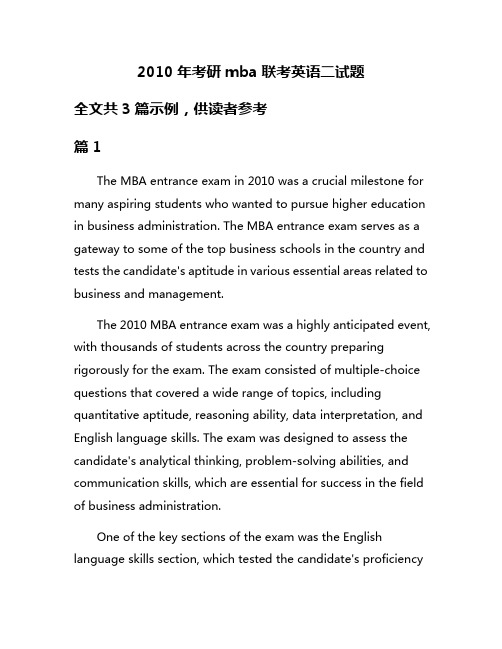
2010年考研mba联考英语二试题全文共3篇示例,供读者参考篇1The MBA entrance exam in 2010 was a crucial milestone for many aspiring students who wanted to pursue higher education in business administration. The MBA entrance exam serves as a gateway to some of the top business schools in the country and tests the candidate's aptitude in various essential areas related to business and management.The 2010 MBA entrance exam was a highly anticipated event, with thousands of students across the country preparing rigorously for the exam. The exam consisted of multiple-choice questions that covered a wide range of topics, including quantitative aptitude, reasoning ability, data interpretation, and English language skills. The exam was designed to assess the candidate's analytical thinking, problem-solving abilities, and communication skills, which are essential for success in the field of business administration.One of the key sections of the exam was the English language skills section, which tested the candidate's proficiencyin English grammar, vocabulary, comprehension, and writing skills. The questions in this section were designed to assess the candidate's ability to comprehend and analyze written passages, understand complex ideas, and express their thoughts clearly and concisely.Overall, the 2010 MBA entrance exam was a challenging yet rewarding experience for many students. Those who prepared diligently and performed well in the exam were able to secure admission to some of the top business schools in the country and kickstart their careers in business administration. The exam served as a stepping stone for many students to achieve their dreams of pursuing higher education in the field of business and management.篇22010年考研mba联考英语二试题Section I Use of English1. It was not until midnight that the fire could be brought under ____.A. controlB. powerC. checkD. management2. The lake, ______ by trees, looked so peaceful that the couple decided to build their house there.A. had surroundedB. to be surroundedC. surroundD. surrounded3. The company's president agreed _______ every employee should receive a bonus this year.A. thatB. aboutC. toD. on4. Robert has friends _______ firmly believes that one's income should be carefully budgeted.A. in whichB. with thatC. of whomD. for those5. In their design, the architects ______ some of the old features of the Victorian building.A. tried to preserveB. are trying to preserveC. preserveD. have preserved6. ___ some of our competitors, we're looking at cutting prices next year to attract new customers.A. As forB. WhileC. For exampleD. Rather than7. Would you like ____ up tonight? I can recommend a couple of good restaurants in the area.A. to dine outB. dine outC. dining outD. in dining out8. _____ many opportunities in the job market, Peter was still unable to find a suitable position.A. DespiteB. AlthoughC. HoweverD. Nevertheless9. The new law is ______ to come into effect next year, so we need to start preparing for it.A. expectedB. anticipatedC. predictedD. awaited10. Over the past decade, there has been a significant ______ in the number of people choosing to work from home.A. expansionB. increaseC. growthD. riseSection II Reading ComprehensionPassage OneQuestions 11-15What are the primary factors contributing to global warming, according to the passage?A. The burning of fossil fuels and deforestation.B. The increase in agricultural activities and urbanization.C. The emission of greenhouse gases and the destruction of the ozone layer.D. The industrial revolution and the expansion of transportation systems.E. All of the above.Passage TwoQuestions 16-20What is the author's main argument in the passage?A. Trees are essential for maintaining ecological balance.B. Forests provide a habitat for a diverse range of species.C. Deforestation is one of the biggest challenges facing our planet.D. The government should implement policies to protect forests.E. None of the above.Passage ThreeQuestions 21-25According to the passage, how has technology changed the way we communicate?A. It has made communication faster and more efficient.B. It has reduced the need for face-to-face interaction.C. It has enabled people to connect with others from around the world.D. It has created new opportunities for businesses to expand globally.E. All of the above.Section III WritingWrite an essay of no more than 500 words on the following topic:"Discuss the impact of technology on modern society. How has technology changed the way we live, work, and communicate? What are the benefits and drawbacks of technological advancement?"Remember to provide examples and evidence to support your arguments.End of Paper.以上是2010年考研mba联考英语二试题的内容,大家可以参考试题来准备自己的备考计划。
中学生标准学术能力测试 英文
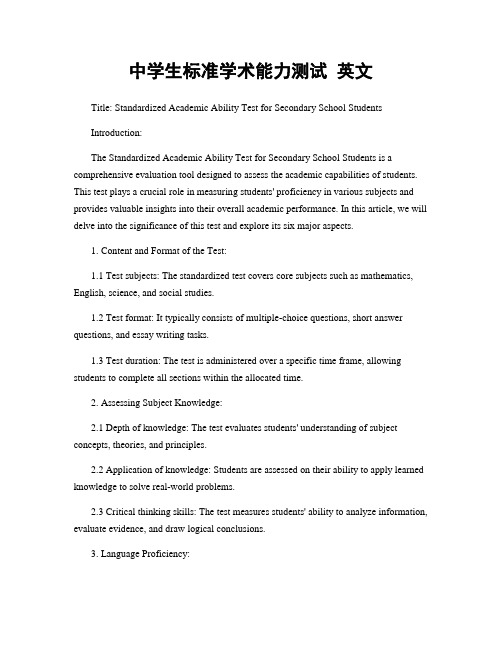
中学生标准学术能力测试英文Title: Standardized Academic Ability Test for Secondary School StudentsIntroduction:The Standardized Academic Ability Test for Secondary School Students is a comprehensive evaluation tool designed to assess the academic capabilities of students. This test plays a crucial role in measuring students' proficiency in various subjects and provides valuable insights into their overall academic performance. In this article, we will delve into the significance of this test and explore its six major aspects.1. Content and Format of the Test:1.1 Test subjects: The standardized test covers core subjects such as mathematics, English, science, and social studies.1.2 Test format: It typically consists of multiple-choice questions, short answer questions, and essay writing tasks.1.3 Test duration: The test is administered over a specific time frame, allowing students to complete all sections within the allocated time.2. Assessing Subject Knowledge:2.1 Depth of knowledge: The test evaluates students' understanding of subject concepts, theories, and principles.2.2 Application of knowledge: Students are assessed on their ability to apply learned knowledge to solve real-world problems.2.3 Critical thinking skills: The test measures students' ability to analyze information, evaluate evidence, and draw logical conclusions.3. Language Proficiency:3.1 Reading comprehension: Students' reading skills are evaluated through passages and questions that assess their ability to comprehend and interpret written texts.3.2 Writing skills: The test assesses students' writing abilities by evaluating their grammar, vocabulary, organization, and coherence in written responses.3.3 Listening and speaking skills: Students' proficiency in listening and speaking is evaluated through audio-based questions and oral presentations.4. Analytical and Problem-Solving Skills:4.1 Data interpretation: The test assesses students' ability to analyze and interpret data presented in graphs, charts, and tables.4.2 Problem-solving: Students are evaluated on their problem-solving skills, including their ability to identify problems, develop strategies, and propose appropriate solutions.4.3 Logical reasoning: The test measures students' ability to think critically, make logical connections, and draw valid conclusions.5. Time Management:5.1 Test preparation: Students are encouraged to develop effective study habits and time management strategies to adequately prepare for the test.5.2 Test-taking strategies: The test assesses students' ability to manage time effectively during the examination, ensuring they complete all sections within the given time frame.5.3 Self-reflection: The test results provide an opportunity for students to reflect on their time management skills and make necessary improvements.6. Test Preparation and Resources:6.1 Study materials: Students can utilize textbooks, reference books, and online resources to enhance their subject knowledge and test-taking skills.6.2 Mock tests: Taking practice tests helps students become familiar with the test format, identify areas of improvement, and build confidence.6.3 Guidance and support: Teachers, parents, and educational institutions play a vital role in providing guidance, support, and resources for effective test preparation.Conclusion:The Standardized Academic Ability Test for Secondary School Students is an essential tool for assessing students' academic proficiency in various subjects. It evaluates their subject knowledge, language proficiency, analytical skills, problem-solving abilities, time management, and test preparation. By recognizing the importance of this test and effectively preparing for it, students can enhance their academic performance and pave the way for future success.。
你在公司负责什么英语作文
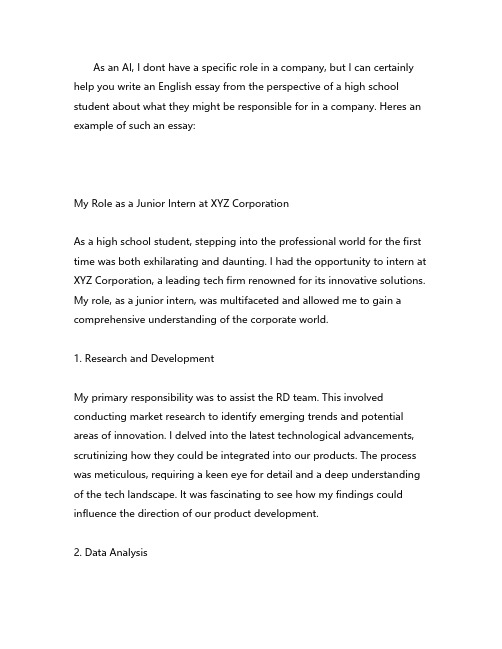
As an AI, I dont have a specific role in a company, but I can certainly help you write an English essay from the perspective of a high school student about what they might be responsible for in a company. Heres an example of such an essay:My Role as a Junior Intern at XYZ CorporationAs a high school student, stepping into the professional world for the first time was both exhilarating and daunting. I had the opportunity to intern at XYZ Corporation, a leading tech firm renowned for its innovative solutions. My role, as a junior intern, was multifaceted and allowed me to gain a comprehensive understanding of the corporate world.1. Research and DevelopmentMy primary responsibility was to assist the RD team. This involved conducting market research to identify emerging trends and potential areas of innovation. I delved into the latest technological advancements, scrutinizing how they could be integrated into our products. The process was meticulous, requiring a keen eye for detail and a deep understanding of the tech landscape. It was fascinating to see how my findings could influence the direction of our product development.2. Data AnalysisData is the lifeblood of any tech company, and I was tasked with helping analyze it. I learned to use various software tools to sort through vast datasets, identifying patterns and insights that could inform business decisions. This role honed my analytical skills and taught me the importance of accuracy and precision in data interpretation.3. Social Media ManagementIn todays digital age, social media is a crucial platform for companies to connect with their audience. I was responsible for managing our companys social media accounts, crafting engaging content, and responding to customer inquiries. This role taught me the power of communication and the art of crafting messages that resonate with diverse audiences.4. Event CoordinationXYZ Corporation frequently hosts events, both online and offline, to engage with stakeholders. I played a pivotal role in coordinating these events, from planning the logistics to ensuring everything ran smoothly on the day. It was a crash course in project management, teaching me how to juggle multiple tasks and think on my feet.5. Mentorship and LearningOne of the most rewarding aspects of my internship was the mentorship I received. I was assigned a mentor who guided me through my responsibilities, providing valuable insights and advice. This relationshipwas instrumental in my growth, both professionally and personally.6. Team CollaborationWorking in a team environment was a new experience for me. I learned the importance of collaboration, communication, and respect for diverse perspectives. Each team member brought unique skills and ideas to the table, and I quickly realized that success in a company is a collective effort.ReflectionMy time at XYZ Corporation was an enriching experience that expanded my horizons and challenged me to step out of my comfort zone. It taught me valuable lessons about responsibility, teamwork, and the dynamic nature of the tech industry. As I look towards the future, I carry these lessons with me, confident in my ability to contribute meaningfully to any team or project.This essay provides a detailed account of a high school students experience and responsibilities in a company, highlighting the learning opportunities and challenges faced.。
关于写实习的英语作文

关于写实习的英语作文英文回答:As an intern at a prestigious multinational corporation, I was tasked with assisting various departments in a multitude of tasks, including market research, business development, and project management. Throughout my internship, I gained invaluable experience that enriched my professional skillset and provided me with a comprehensive understanding of the corporate world.In the market research department, I assisted in conducting customer surveys, analyzing market trends, and developing marketing strategies based on the collected data. This experience honed my analytical and data interpretation skills, enabling me to identify customer pain points and formulate effective marketing campaigns.Within the business development team, I actively participated in client meetings, prepared salespresentations, and assisted in closing deals. I gained practical knowledge of the sales process, from prospecting to negotiation, and developed strong communication and interpersonal skills.Additionally, I was involved in several project management initiatives, where I assisted in planning, scheduling, and executing projects. This experience enhanced my organizational and time management abilities, as well as my ability to effectively collaborate with a diverse team.Overall, my internship was an invaluable learning experience that equipped me with a solid foundation in business fundamentals, fostered my analytical and communication skills, and ignited my passion for the corporate world. I am confident that the skills and experience I acquired during my internship will serve me well in my future endeavors.中文回答:作为一家著名跨国公司的实习生,我被分配到多个部门协助完成各种任务,包括市场调研、业务拓展和项目管理。
- 1、下载文档前请自行甄别文档内容的完整性,平台不提供额外的编辑、内容补充、找答案等附加服务。
- 2、"仅部分预览"的文档,不可在线预览部分如存在完整性等问题,可反馈申请退款(可完整预览的文档不适用该条件!)。
- 3、如文档侵犯您的权益,请联系客服反馈,我们会尽快为您处理(人工客服工作时间:9:00-18:30)。
<1010>Analytical data interpretation and treatment 分析数据解释及处理IntroductionThis chapter provides information regarding acceptable practices for the analysis and consistent interpretation of data obtained from chemical and other analyses.Basic statistical approaches for evaluating data are described,and the treatment of outliers and comparison of analytical methods are discussed in some detail.序论这一章节提供了对从化学和其他的实验中获得的信息如何进行合理分析和一致解释的信息。
评估数据的基本统计方法,如何处理极端数据及分析方法的比较在一些章节中进行讨论。
NOTE---It should not be inferred that the analysis tools mentioned in this chapter form an exhaustive list .Other ,equally valid,statistical methods may be used at the discretion of the manufacture and other users of this chapter.注意---没必要从一个详细的清单中推断这一章节提到的分析工具。
其他等效的统计方法也可能被用于慎密的制造或被其他用户使用。
Assurance of the quality of pharmaceuticals is accomplished by combining a number of practices,including robust formulation design,validation,testing of starting materials,in-process testing ,andfinal-product testing,Each of these practices is dependent on reliable test methods.In the development process ,test procedures are developed and vaildated to ensure that the manufactured products are thoroughly characterized. Final-product testing provides further assurance that the products are consistently safe ,efficacious,and in compliance with their specification.Measurements are inherently variable .The variability of biological tests has long been recognized by the USP,For example ,the need to consider this variability when analyzing biological test data is addressed under Design and Analysis of Biological Assays<111>.The chemical analysis measurements commonly used to analyze pharmaceuticals are also inherently variable,although less so than those of the biological tests.However,in many instances the acceptance criteria are proportionally tighter,and thus ,this smaller allowable variability has to be considered when analyzing data generated using analytical procedures.If the variability of a measurement is not characterized and stated along with the result of the measurement, then the data can only be interpreted in the most limited sense.For example ,stating that the difference between the averages from two laboratories when testing a commom set of samples is 10% has limited interpretation ,in terms of how important such a difference is , without knowledge of the intralaboratory variability.This chapter provides direction for scientifically acceptabletreatment and interpretation of data .Statistical tools that may be helpful in the interpretation of analytical data are described.Many descriptive statistics, such as the mean and standard deviation ,are in commom use.Other statistical tools ,such as outlier tests,can be performed using several different,scientifically valid approaches , and examples of these tools and their applications are also included. The framwork within which the results from a compendial test are interpreted is clearly outlined in Test Results,Statistics,and Standards under General Notices and Requirements.Selected references that might be helpful in obtaining additional information on the statistical tools discussed in this chapter are listed in Appendix F at the end of the chapter. USP does not endorse these citations,and they do not represent an exhaustive list. Further information about many of the methods cited in this chapter may also be found in most ststistical textbooks.PREREQUISITE LABORA TORY PRACTICES ANDPRINCIPLESThe sound application of statistical principles to laboratory data requires the assumption that such data have been collected in a traceable (i.e.,documents) and unbiased manner.To ensure this ,the following practices are beneficial.Sound Record KeepingLaboratory records are maintained with sufficient detail ,so thatother equally qualified analysts can reconstruct the experimental conditions and review the results obtained.When collecting data,the data should generally be obtained with more decimal places than the specification requires and rounded only after final calculations are completed as per the General Notices and Requirements.Sampling ConsiderationsEffective sampling is an important step in the assessment of a quality attribute of a population . The purpose of sampling is to provide representative data(the sample) for estimating the properties of the population. How to attain such a sample depends entirely on the question that is to be answered by the sample data . In general,use for random process is considered the most appropriate way of selecting a sample.Indeed ,a random and independent sample is necessary to ensure that the resulting data produce valid estimates of the properties of the population.Generating a nonrandom or “convenience”sample risks the possibility that the estimates will be biased, The most straightforward type of random sampling is called sample random sampling, a process in which every unit of the population has an equal chance of appearing in the sample. However , sometimes this method of selecting a random sample is not optimal because it cannot guarantee equal representation among factors (i.e.,time ,location,machine) that may influnece the critical properties of the population. For example,if it requires 12 hours tomanufacture all of the units in a lot and it is vital that the sample be representative of the entire production process , then taking a simple random sample after the production has been completed may not be appropriate because there can be no guarantee that such a sample will contain a similar number of units made from every time period within the 12-hour process. Instead, it is better to take a systematic random sample where by a unit is randomly selected from the production process at systematically selected times or locations(e.g.,sample every 30 minutes from the units produced at that time) to ensure that units taken throughout the entire manufacturing process are included in the sample.Another type of random sampling procedure is needed if ,for example,a product is filled into vials using four different filling machines .In this case it would be important to capture a random sample of vials from each of the filling machines .A stratified random sample, which randomly samples an equal number of vials from each of the four filling machines ,would satisfy this requirement . Regardless of the reason for taking a sample (e.g.,batch-release testing ), a sampling plan should be established to provide details on how the sample is to be obtained to ensure that the sample is representative of the entirety of the population and that the resulting data have the required sensitivity . The optimal sampling strategy will depend on knowledge of the manufacturing and analytical measurement processes.Once the sampling scheme has been defined,it islikely that the sampling will include some element of random selection . Finally , there must be sufficient sample collected for the original analysis, subsequent verification analyses , and other analyses.Tests discussed in the remainder of this chapter assume that simple random sampling has been performed.Use of Reference StandardsWhere the use of the USP Reference Standard is specified, the USP Reference Standard, or a secondary standard traceable to the USP Reference Standard, is used . Because the assignment of a value to a standard is one of the most important factors that influences the accurary of an analysis,it is critical that this be done correctly.System Performance V erificationV erifying an acceptable level of performance for an analytical system in routine or continuous use can be a valuable practice . This may be accomplished by analyzing a control sample at appropriate intervals , or using other means ,such as ,variation among the standards, backgroud signal-to-noise ratios,etc. Attention to the measured parameter , such as charting the results obtained by analysis of a control sample , can signal a change in performance that requries adjustment of the analytical system.Method V alidationAll methods are appropriately validated as specified under Validation of Compendial Methods<1225>.Methods published in theUSP-NF have been validated and meet the Current Good Manufacturing Practices regulatory requirement for validation as established in the Code of Federal Regulations, A validated method may be used totest a new formulation (such as a new product,dosage form, or process intermediate) only after confirming that the new formulation does not interfere with the accurary ,linearity ,or precision of the method.It may not be assumed that a validated method could correctly measure the active ingredient in a formulation that is different from that used in establishing the original validity of the method.MEASUREMENT PRINCIPLES AND V ARIA TION All measurement are, at best, estimates of the actual (“true”or “accepted”) value for they contain random variability (also referred to as random error) and may also contain systematic variation (bias). Thus,the measured value differs from the actual value because of variability inherent in the measurement .If an array of measurement consists of individual results that are representative of the whole,statistical methods can be used to estimate informative properties of the entirety, and statistical tests are available to investigate whether it is likely that these properties comply with given requirements . The resulting statistical analyses should address the variability associated with the measurement process as well as that of the entity being measured . Statistical measures used to assess the direction and magnitude of these errors include themean,standard deviation , and expressions derived therefrom ,such as the coefficient of variation (CV, also called the relative standard deviation , RSD).The estimated variability can be used calculate confidence intervals for the maen, or measures of variability , and tolerance intervals capturing a specified proportion of the individual measurements.The use of statistical measures must be tempered with good judgment , especially with regard to representative sampling. Most of the statistical measures and tests cited in this chapter rely on the assumptions that the distribution of the entire population is represented by a normal distribution and that the analyzed sample is a representative subset of this population. The normal (or Gaussian) distribution is bell-shaped and symmetric about its center and has certain characteristics that are required for these tests to be valid. If the assumption of a normal distribution for the population is not warranted, then normality can often be achieved (at least approximately) through an approptriate transformation of the measurement values.For example, there exist variables that have distributions with longer right tails than left. Such distributions can often be made approximately normal through a log transformation. An alternative approach would be to use “distribution-free”or “nonparametric”statistical procedures that do not require that the shape of the population be that of a normal distribution . When the objective is to construct a confidence interval for the mean or for the differencebetween。
